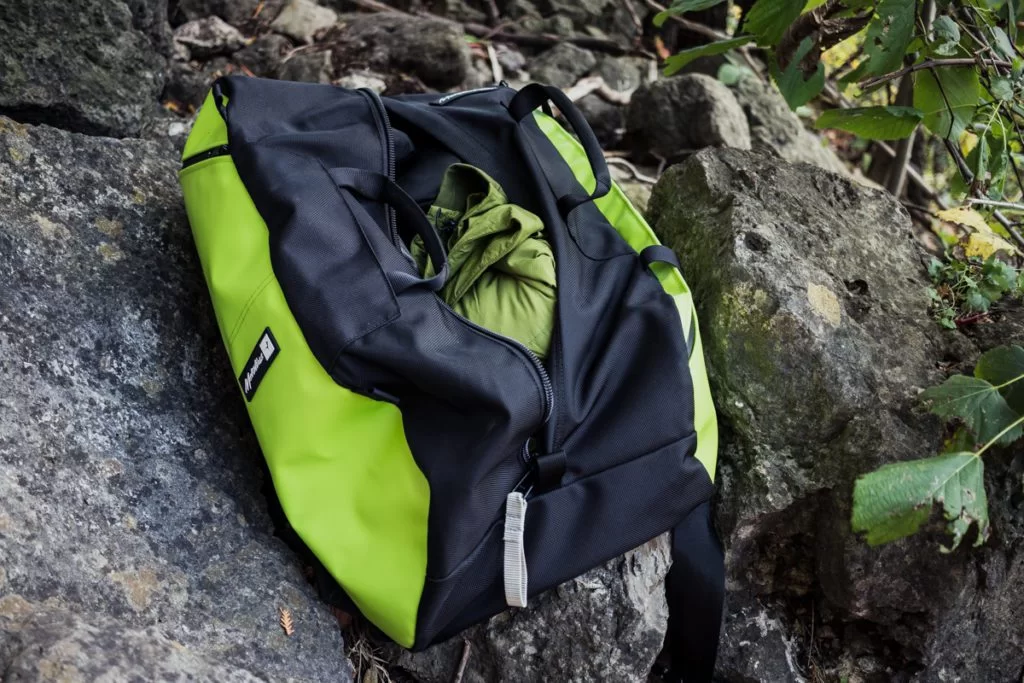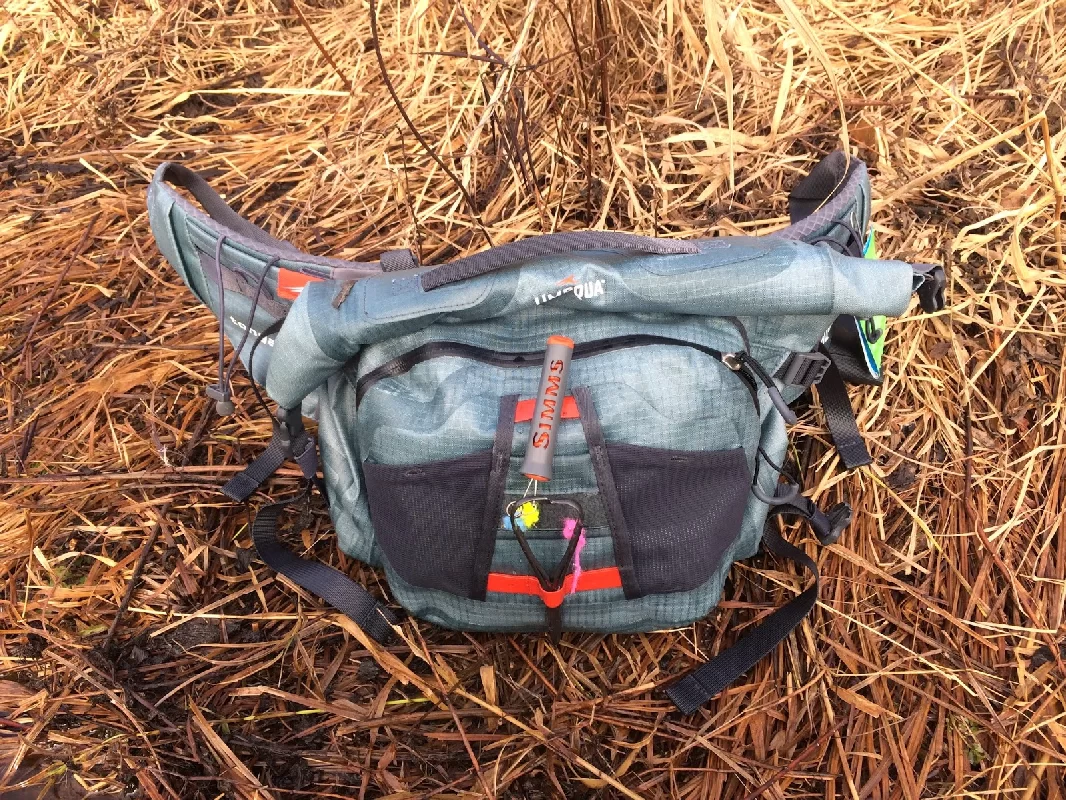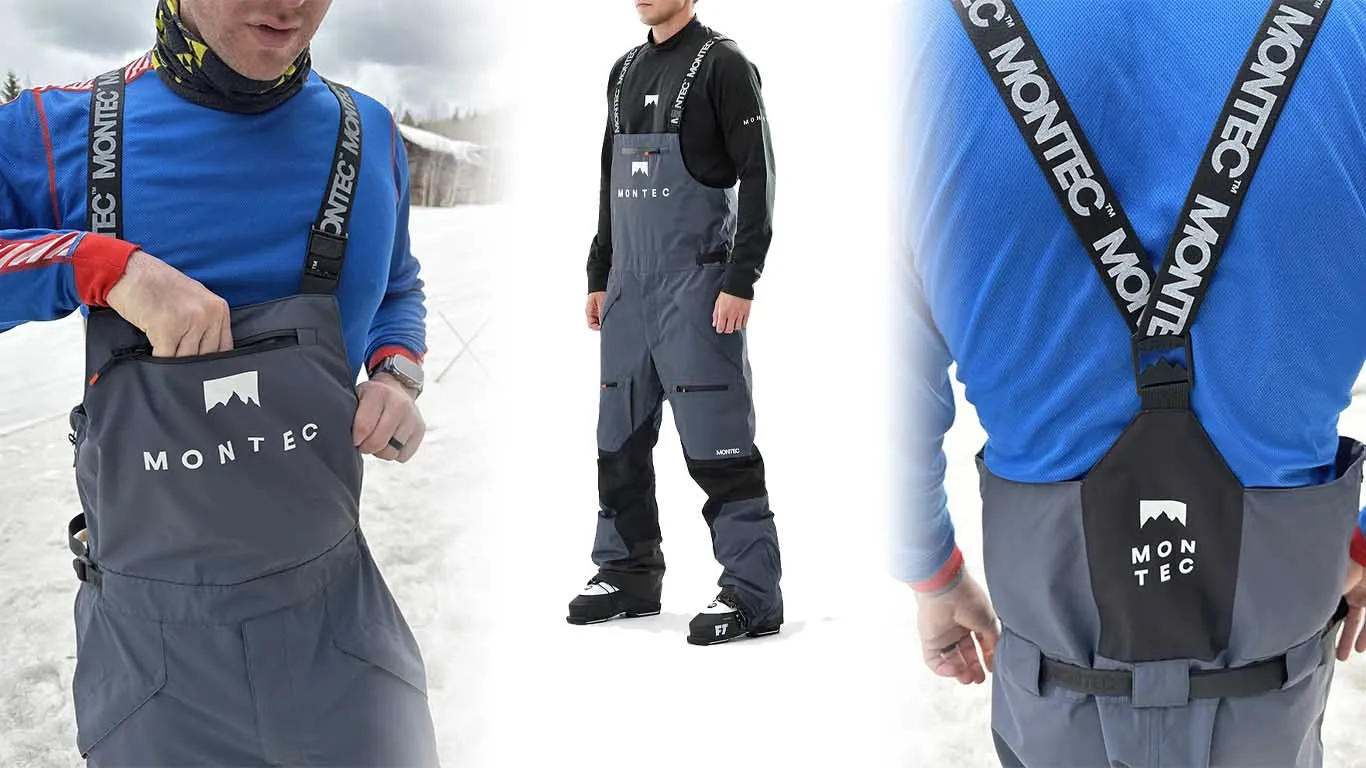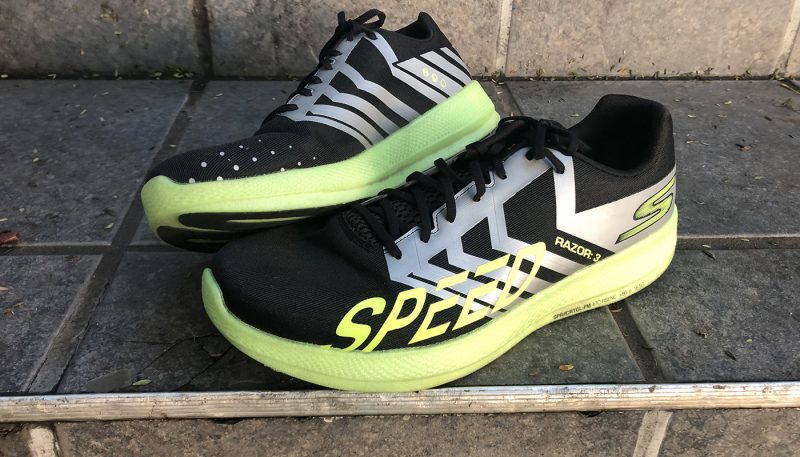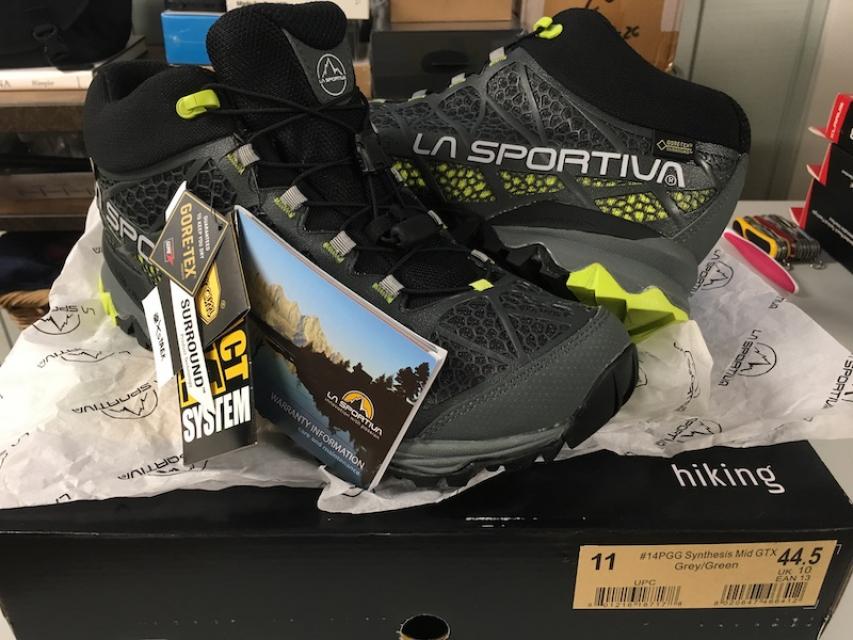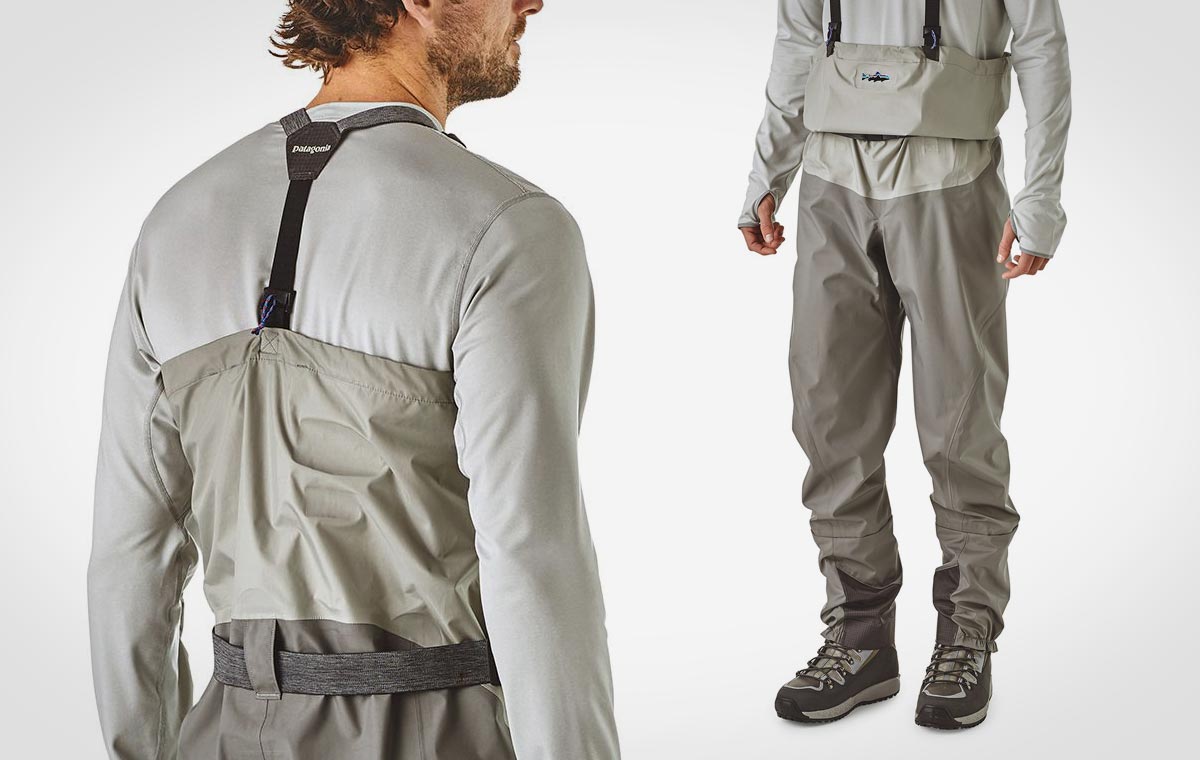Whether you’re setting out on a casual day hike or hitting the trail with overnight gear, there’s a hiking shoe up for the task. Compared to traditional hiking boots, hiking shoes are characterized by their low-top design, which translates to less weight on your feet for covering ground quickly. To compile our top picks, the female editors at Switchback Travel took to the trail, testing out everything from heavy-duty leather hikers to cushioned trail runners and approach shoes originally intended for climbing. Below are the best women’s hiking shoes of 2024. For more background information, see our women’s hiking shoe comparison table and buying advice below the picks. And for a full list of options, including both men’s and women’s styles, check out our article on the best hiking shoes.
Editor’s note: We updated our women’s hiking shoes guide on May 8, 2024, to swap several shoes to the latest designs, including the Merrell Moab Speed 2, Altra Lone Peak 8, and La Sportiva TX4 Evo. We also added information about our testing process and swept the guide to ensure all prices, specs, and colorways are current.
Our Team’s Women’s Hiking Shoe Picks
- Best Overall Hiking Shoe: Merrell Moab Speed 2
- Best Lightweight/Cushioned Hiking Shoe: Hoka Speedgoat 5
- Best Budget Hiking Shoe: Merrell Moab 3
- Best Supportive Shoe for Backpacking: La Sportiva Spire GTX
- Best Hiking Shoe for Off-Trail Scrambling: La Sportiva Ultra Raptor II
- A Comfortable Shoe for Hard-to-Please Feet: Altra Lone Peak 8
Best Overall Women’s Hiking Shoe
1. Merrell Moab Speed 2 ($140)
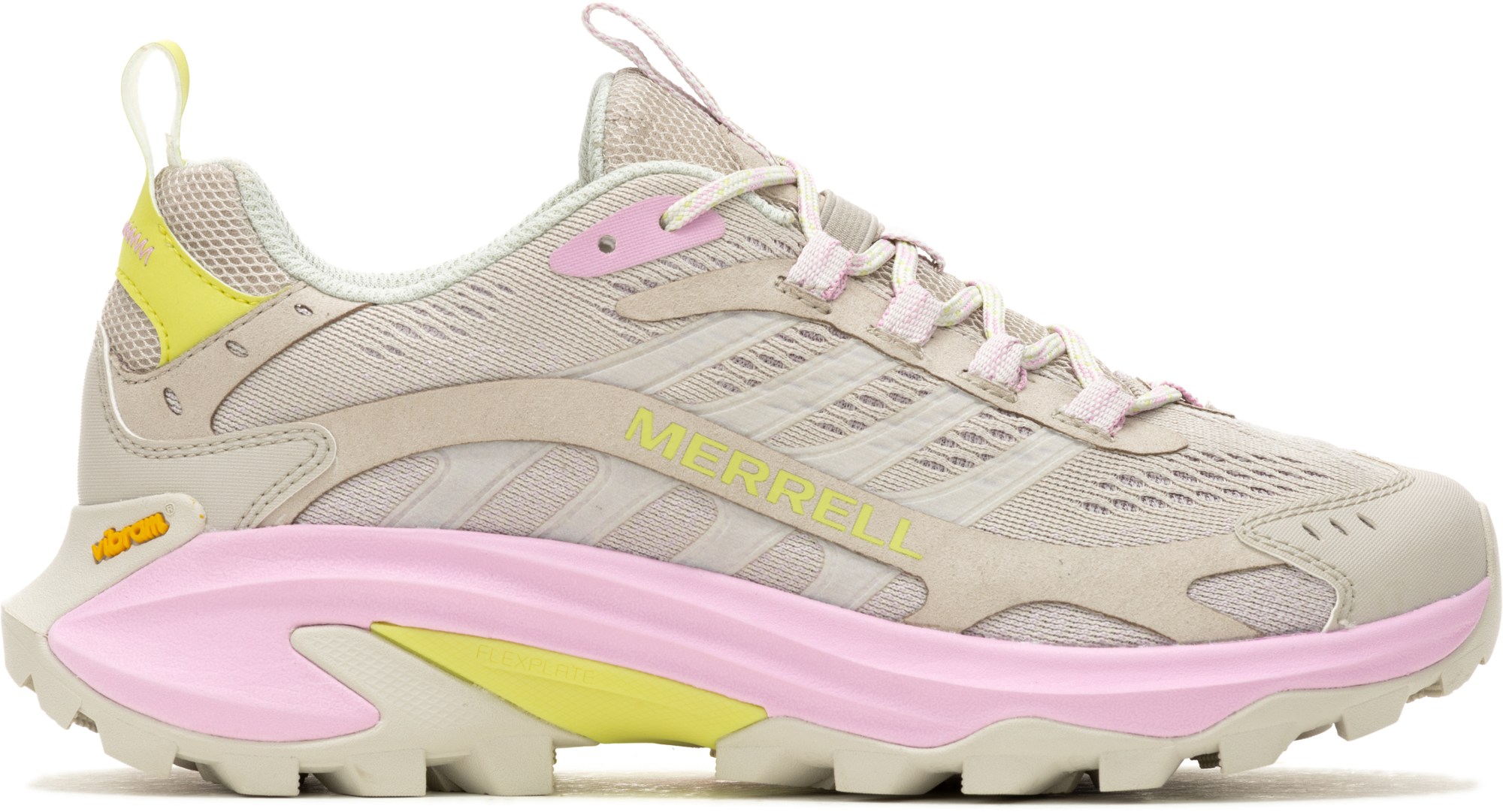
Category: Hiking shoe
Weight: 1 lb. 3.4 oz.
Waterproof: No (available)
What we like: Extremely well rounded—this shoe checks all the right boxes for most hikers.
What we don’t: Roomy toe box and lack of secure heel detract from security and performance on technical terrain.
Merrell has long been a leader in hiking footwear, and the recently updated Moab Speed 2 takes the cake as our top women’s shoe this year. The original Moab Speed brought the much-loved Moab (below) into the modern era, and the latest “2” carries the torch with a lightweight and cushioned build that will appeal to day hikers and weight-conscious backpackers alike. And despite its trail-runner-esque appearance, the Merrell still offers a healthy amount of protection and support—including a generous toe and heel cap and firm midsole—along with a capable Vibram outsole. Merrell also boosted comfort with the latest iteration by utilizing 30% more foam in the midsole, leading to a noticeably cushier and less rigid feel. The end result is a hardwearing yet easy-to-wear hiking shoe that toes the line between weight-savings and on-trail performance better than most—and the price is right too at just $140.
The Moab Speed 2 will get the job done for the majority of day hikers and ultralight backpackers, but it wouldn’t be our first choice for technical objectives that involve a lot of off-trail travel or scrambling. Our biggest gripes with the latest model were the wide toe box and lack of security at the heel, which resulted in a slightly sloppy feel. If you’re headed out on challenging terrain or with a heavy pack, models like the La Sportiva Spire and Ultra Raptor II below will offer more security and underfoot stability (at the cost of cushy comfort). On the other end of the spectrum, the Speed feels decidedly firmer and more planted than the Speedgoat below but lacks the Hoka’s snug and sock-like feel. In the end, it’s a tall order to recommend a single shoe for a range of hikers and venues, but the Moab Speed 2 nails the all-around equation better than most…
Best Lightweight/Cushioned Hiking Shoe
2. Hoka Speedgoat 5 ($155)
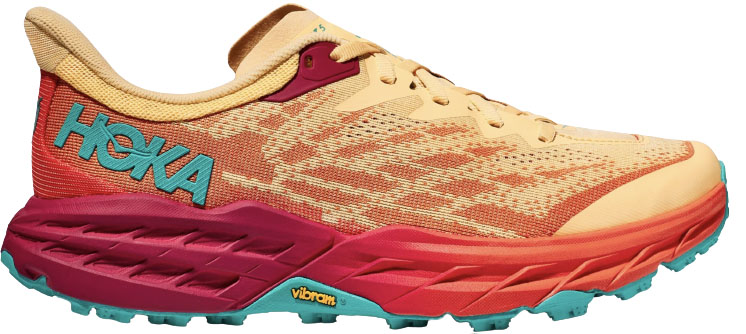
Category: Trail runner
Weight: 1 lb. 1 oz.
Waterproof: No (available)
What we like: A lightweight and well-cushioned shoe, great for moving quickly on the trail.
What we don’t: Tall stack height and soft midsole can result in instability.
Running brand Hoka is no stranger to trail-ready footwear, and their lightweight and cushioned designs have made a recent splash in the hiking market. Built as a trail runner, the Speedgoat 5 has been adopted by the thru-hiking community as a durable, capable shoe that can meet the demands of hikers and minimalist backpackers alike. In true Hoka style, the Speedgoat features a super thick midsole that isolates you nicely from uneven terrain, and you still get ample firmness for covering serious ground. Following suit, the outsole is impressively grippy and—although non-traditional—we found ourselves really appreciating the athletic and sprightly feel of the rockered sole.
If you’re thinking about going with a trail running shoe for hiking, there are a few important considerations to keep in mind. In terms of trail performance, you get far less protection from rocks and roots, and the flexible build translates to noticeably less stability on uneven ground (especially while carrying a load). And durability-wise, a minimalist shoe like the Speedgoat will pack out, abrade, and lose its cushion more quickly than a burly hiking-specific model. It’s also worth noting that the fifth-gen Speedgoat features a softer midsole than the 4, along with a less durable upper (it is lighter and more breathable, however)—which benefits runners but isn’t necessarily great news for hikers. That said, it’s hard to argue with the myriad thru-hikers that routinely log 20-plus-mile days (with an overnight load) wearing the Speedgoat. For those that stick to the trail and travel light and fast, the Hoka is definitely worth a look.
Best Budget Hiking Shoe
3. Merrell Moab 3 ($120)
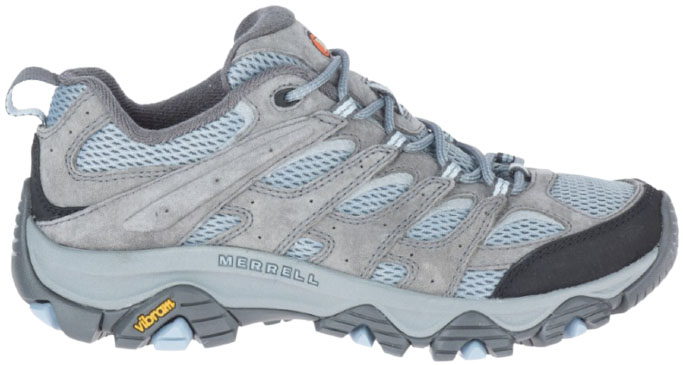
Category: Hiking shoe
Weight: 1 lb. 9.1 oz.
Waterproof: No (available)
What we like: A durable shoe for an affordable price.
What we don’t: Heavy and not built for technical terrain.
For those who prefer a more traditional hiking shoe, there’s a lot to love about the Moab 3. Merrell found a winning formula here, combining a comfortable fit with a sturdy yet lightweight feel—all for an affordable $120. The leather upper means you get a boost in protection and durability compared to synthetic designs like the Moab Speed above, and mesh panels offer better ventilation than an all-leather model like the La Sportiva TX4 Evo below. All in all, the Moab 3 is a hardwearing and time-tested solution for day hikers and casual overnighters alike.
While the Moab 3 checks all the boxes for moderate trails, the shoe is not meant for fast-paced or off-trail endeavors. On rocky and muddy trails, we’ve found that traction and stability fall short of grippier and closer-fitting designs like the Hoka Speedgoat above and Salomon X Ultra 4 GTX below. And despite clocking in well under 2 pounds, the Merrell is one of the heaviest shoes here and will feel clunky and cumbersome if you’re used to a more trail runner-inspired design. But for folks that don’t need cutting-edge performance, the Moab 3 is a wonderful hiking shoe with a long and reputable track record to back it up. Finally, Merrell also makes the Moab 3 Waterproof, which retails for $140 and checks in at a comparable 1 pound 10.1 ounces. And if you’d prefer a more modern budget design, check out the Adidas Terrex AX4 ($100) below.
Best Supportive Shoe for Backpacking
4. La Sportiva Spire GTX ($209)
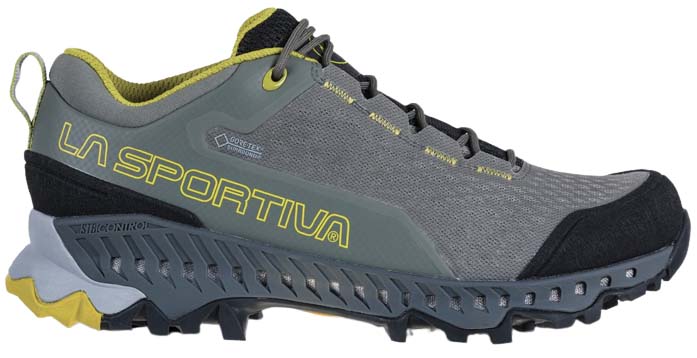
Category: Hiking shoe
Weight: 1 lb. 10.2 oz.
Waterproof: Yes
What we like: Raised collar offers more ankle support than most shoes here.
What we don’t: Heavy and pricey.
We hesitate recommending many of the shoes here for much more than hiking on established trails, but the burly La Sportiva Spire GTX is a notable exception. In short, the Spire is about as close to backpacking-ready as a hiking shoe gets—with a relatively high collar, La Sportiva goes so far as calling it a low-cut hiking boot. The thickly cushioned yet relatively stiff midsole offers a great balance of comfort, protection, and support, which comes in handy for high-mileage days and off-trail scrambling. Throw in excellent grip, good breathability (for a waterproof design), and the top-shelf quality we’ve come to expect from this Italian climbing brand, and you have one of the more capable hiking shoes on the market.
But the Spire isn’t for everyone: At $209, it’s the most expensive pick on this list by a long shot. Second, with a rather stiff and heavy build (1 lb. 10.2 oz. for the pair), it’s definitely more shoe than most day hikers need. For a nice middle ground, it’s worth considering La Sportiva’s much lighter (1 lb. 2.4 oz.) Akasha II trail runner, which is noticeably softer and less supportive than the Spire but well equipped for moving quickly over technical terrain—ideal for hikers looking to retain agility without totally sacrificing protection. If you opt for the Spire, take note that it’s only offered in a waterproof version, which is great for early-season snow and colder weather but prone to overheating on mid-summer days at low elevations. Most day hikers will want to look elsewhere, but for backpackers and those frequently traveling off trail or above treeline in areas like the High Sierra or Colorado Rockies, the Spire offers an excellent combination of support, durability, and protection.
Best Hiking Shoe for Off-Trail Scrambling
5. La Sportiva Ultra Raptor II ($149)
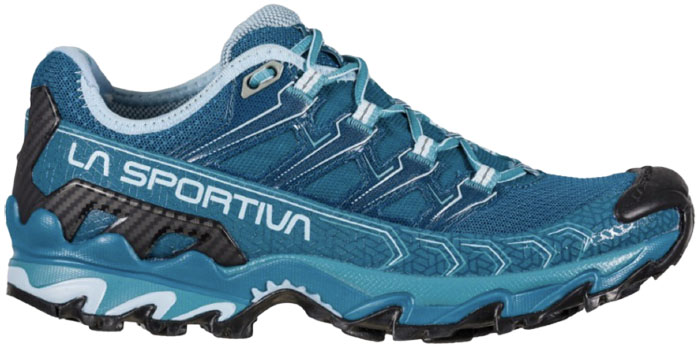
Category: Trail runner/hiking shoe
Weight: 1 lb. 4.8 oz.
Waterproof: No
What we like: Incredibly capable in mountain terrain; top-notch protection and grip.
What we don’t: Relatively stiff and clunky; not as durable as a leather shoe.
La Sportiva bills their Ultra Raptor as a mountain running shoe, but we’re big fans of this design for hikes venturing above treeline on rugged trails or cross-country terrain. Now in its second iteration, the Ultra Raptor II provides protection against rocks and roots by way of generous toe and heel caps and a full-length rock plate, along with incredible grip on everything from mud and loose talus to boulders and snow (borrowed from Sportiva’s climbing collection, the Vibram FriXion XF is especially sticky on rock). Ample cushion makes the shoe comfortable enough to wear all day, and a sock-like construction keeps the foot snug while sealing out most trail debris. For high routes, climbing approaches, and peak bagging, it doesn’t get much better than the Ultra Raptor II.
But for all the La Sportiva’s strengths, it’s not our shoe of choice for easy trails. Compared to most trail runner-inspired designs, the Ultra Raptor is rather stiff and clunky, and the rigid TPU heel counter is known to cause discomfort in the heel for some. Second, although it’s built with mesh, the shoe’s upper has a tendency to absorb rather than drain water, which isn’t ideal after creek or snow crossings. And finally, it’s simply not as durable as a leather design like La Sportiva’s TX4 Evo below, although we do prefer the added breathability for summery conditions. But these are relatively minor trade-offs for hikers who spend a lot of time above treeline…
A Comfortable Shoe for Hard-to-Please Feet
6. Altra Lone Peak 8 ($140)
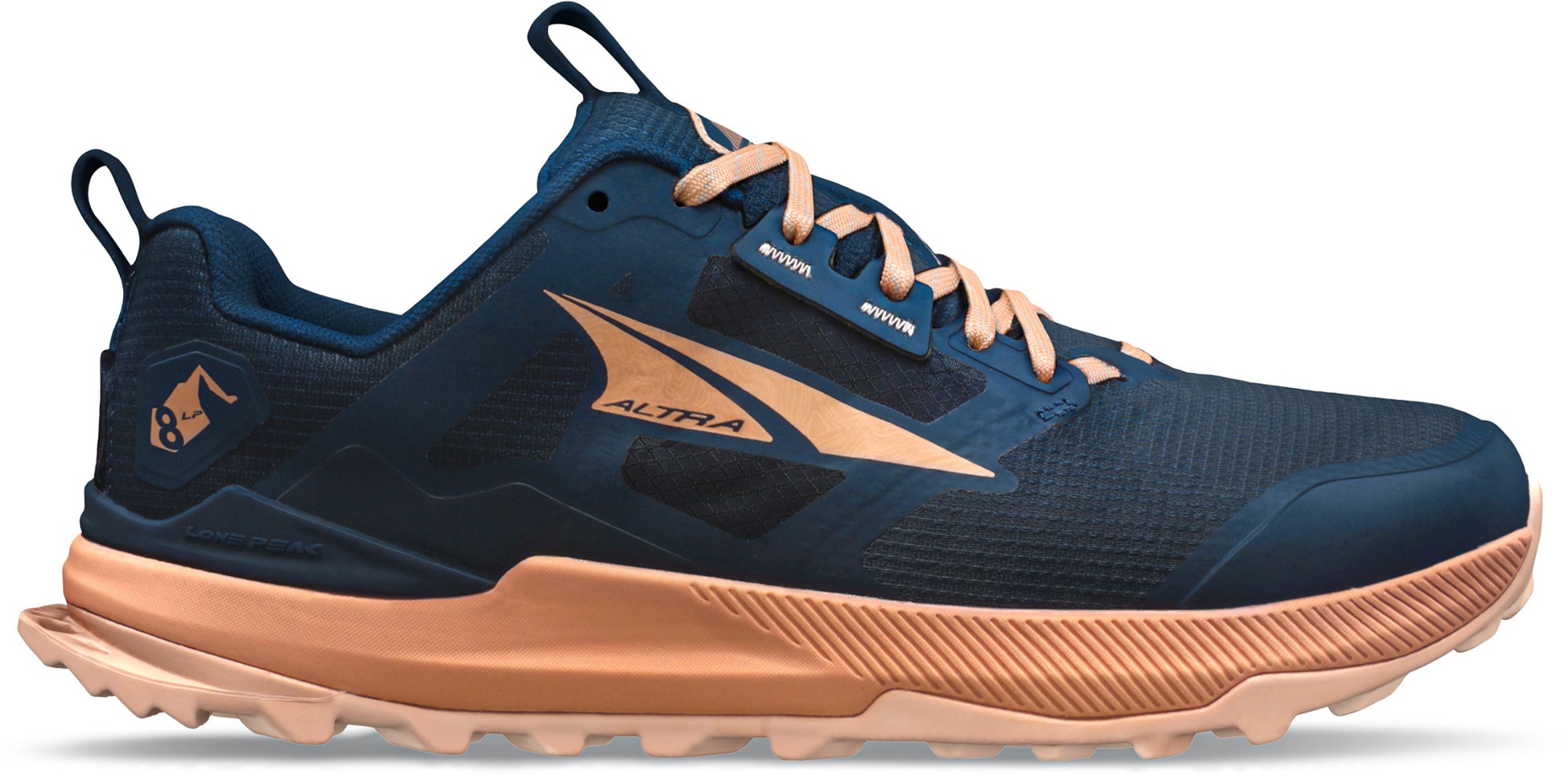
Category: Trail runner
Weight: 1 lb. 2.3 oz.
Waterproof: No (available)
What we like: Flat and roomy footbed offers slipper-like comfort.
What we don’t: Can feel sluggish, squirrely, and imprecise, especially on technical terrain.
If you’re among the myriad hikers who suffer from the pressure points, hot spots, and blisters resulting from ill-fitting shoes, this one’s for you. Popularized by the barefoot running movement, Altra’s zero-drop offerings are arguably the most ergonomic and comfortable on the trail, and their flagship Lone Peak has earned legendary status among the thru-hiking community. With a flat footbed and extra-roomy toe box, the shoe allows the foot to stay in its naturally prone and splayed position, which is great news for those with wide or particularly finicky feet. We’ve recommended the Lone Peak to dozens of friends and acquaintances who’ve struck out with more traditional hiking shoes and have yet to lead anyone astray.
The Lone Peak seems to get a little better with each update. In comparing the latest 8 to the past-generation 7, the newer model boasts a moderately more aggressive outsole and a “Ghillie” lacing system with optional pull-through points for a more customizable fit. Altra also simplified the upper while boosting durability and slashed $10 off the price (always a welcome change in today’s increasingly expensive market). True to its trail-worthy intentions, the Lone Peak also features a rock plate and gaiter attachments. The zero-drop design certainly isn’t for everyone—albeit comfortable, we’ve found the Lone Peak to be sluggish, under-cushioned (you get just 25mm of stack height compared to the Speedgoat’s 33mm in the heel), and lacking in arch support—but for some feet, it simply doesn’t get any better.
Best of the Rest
7. The North Face Vectiv Fastpack Futurelight ($149)
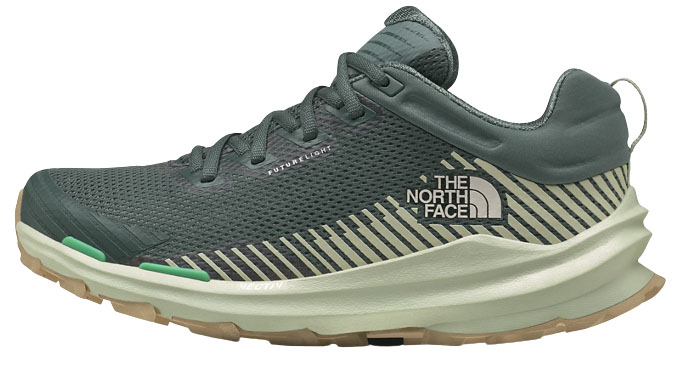
Category: Hiking shoe
Weight: 1 lb. 3.2 oz.
Waterproof: Yes
What we like: Comfortable and quick-moving; outsole offers great all-around traction.
What we don’t: Limited durability and minimal support on off-camber terrain.
The North Face’s footwear lineup has seen a lot of modernization in recent years, and the Fastpack is a case in point. Taking inspiration from their Vectiv trail running collection, this hiking-specific variation features an airy mesh upper and rockered profile that will have you feeling light and fast on the trail. But the Fastpack ups the ante compared to a standard trail runner, with a TPU plate under the forefoot for stability and a generous toe cap to guard against roots and rocks. If you like to move quickly but want hiking-shoe levels of stability and protection, the Fastpack is a great place to start.
We took the Vectiv Fastpack hiking in southern Patagonia and returned with mostly positive impressions. The rockered profile felt relatively natural underfoot, and we were big fans of the sticky SurfaceCtrl outsole, which gripped well on everything from wet boulders and logs to hard-packed mud. Further, the waterproof membrane kept our feet dry despite rainy conditions and numerous creek crossings. But while the Fastpack is surprisingly capable on challenging terrain, it’s worth noting that it won’t have the longest lifespan—the soft foam will pack out over time, and after just 14 miles, our pair had sustained sizable abrasions in the upper. Gripes aside, the TNF is an easy-to-love, quick-moving shoe and one of our favorite all-rounders of the year…
8. Salomon X Ultra 4 GTX ($160)
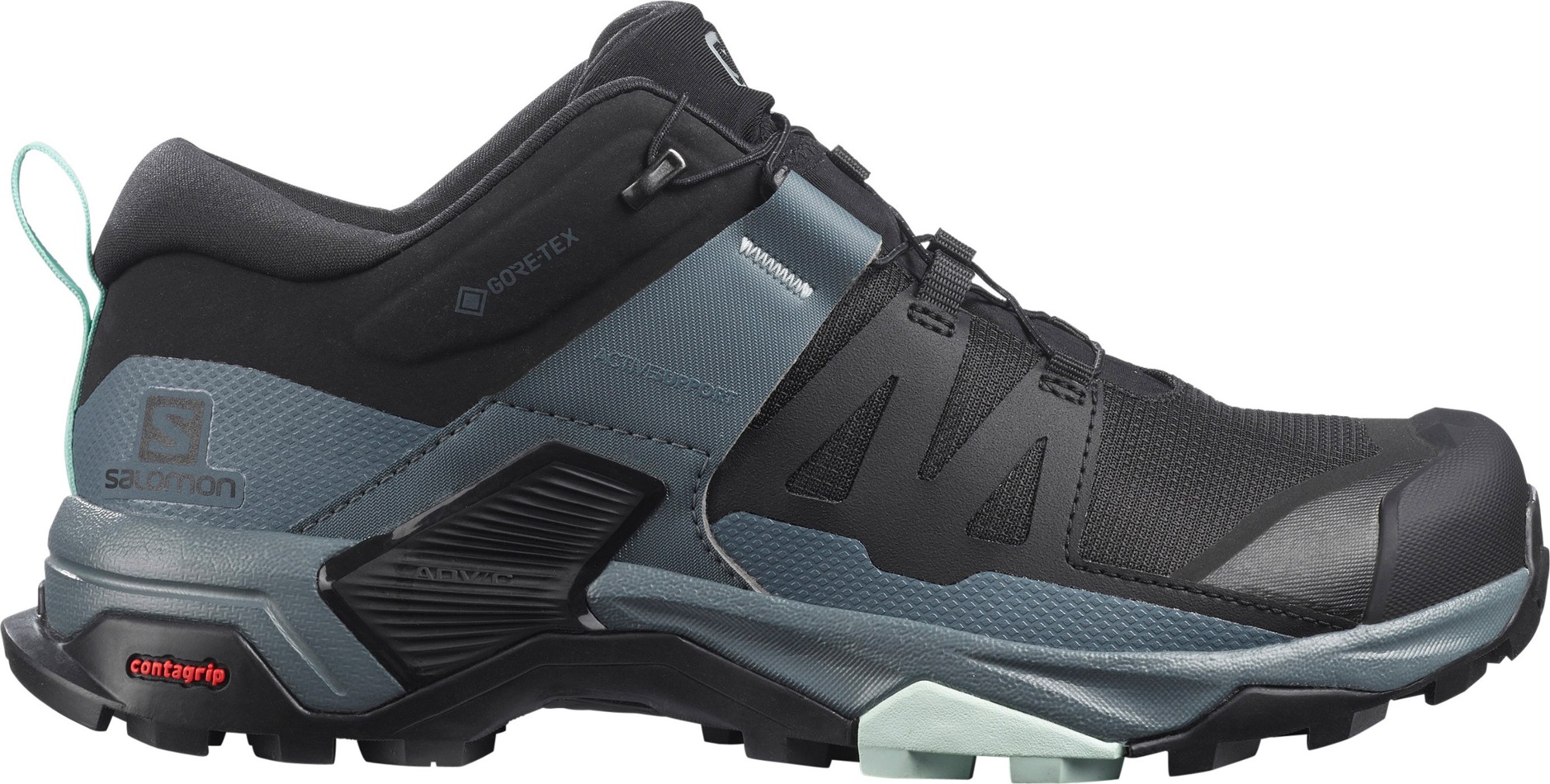
Category: Hiking shoe
Weight: 1 lb. 9.6 oz.
Waterproof: Yes (non-GTX available)
What we like: Stable and durable without feeling too heavy.
What we don’t: Strange fit and odd underfoot feel; several user reports of quality-related issues.
Salomon’s X Ultra has been one of our favorite hiking shoes for years running, offering an exceptional combination of comfort, on-trail performance, and durability for everything from casual day hikes to long overnight missions. A few years ago, they released an update to the much-loved shoe in the X Ultra 4 here. Beyond its sleeker and more modern look, the X Ultra 4 features a revised lacing system and chassis, along with a wider fit in the toe box. Importantly, the shoe retains the outgoing version’s fantastic mix of agility, durability, and protection, and there’s enough cushioning underfoot for full days with a loaded pack. Finally, at 1 pound 9.6 ounces (our size 8.5 clocked in at 1 lb. 7.6 oz.), it’s also a close match to its predecessor in terms of weight.
The X Ultra held our top spot for years running, but we were forced to reconsider after thoroughly testing the most recent version. In short, we’re not huge fans of the 4’s fit, which features a narrow midfoot along with a very spacious forefoot. For some, this offers a locked-down feel but perhaps too roomy of a toe box; for others (ourselves included), it’s ideal in the forefoot but too tight at the arch. Further, we found the X Ultra 4 to have an odd combination of stiffness in the heel and flexibility in the midfoot, which can result in sore feet. Finally, we can’t ignore the score of quality-related complaints, including lack of tongue security and premature delamination along the upper (we didn’t experience these ourselves). These issues are enough for us to hesitate in moving the updated shoe any higher on our list, but if you can try it on before you purchase (and it fits), the latest X Ultra is a high-performance and versatile design…
9. Danner Trail 2650 ($170)
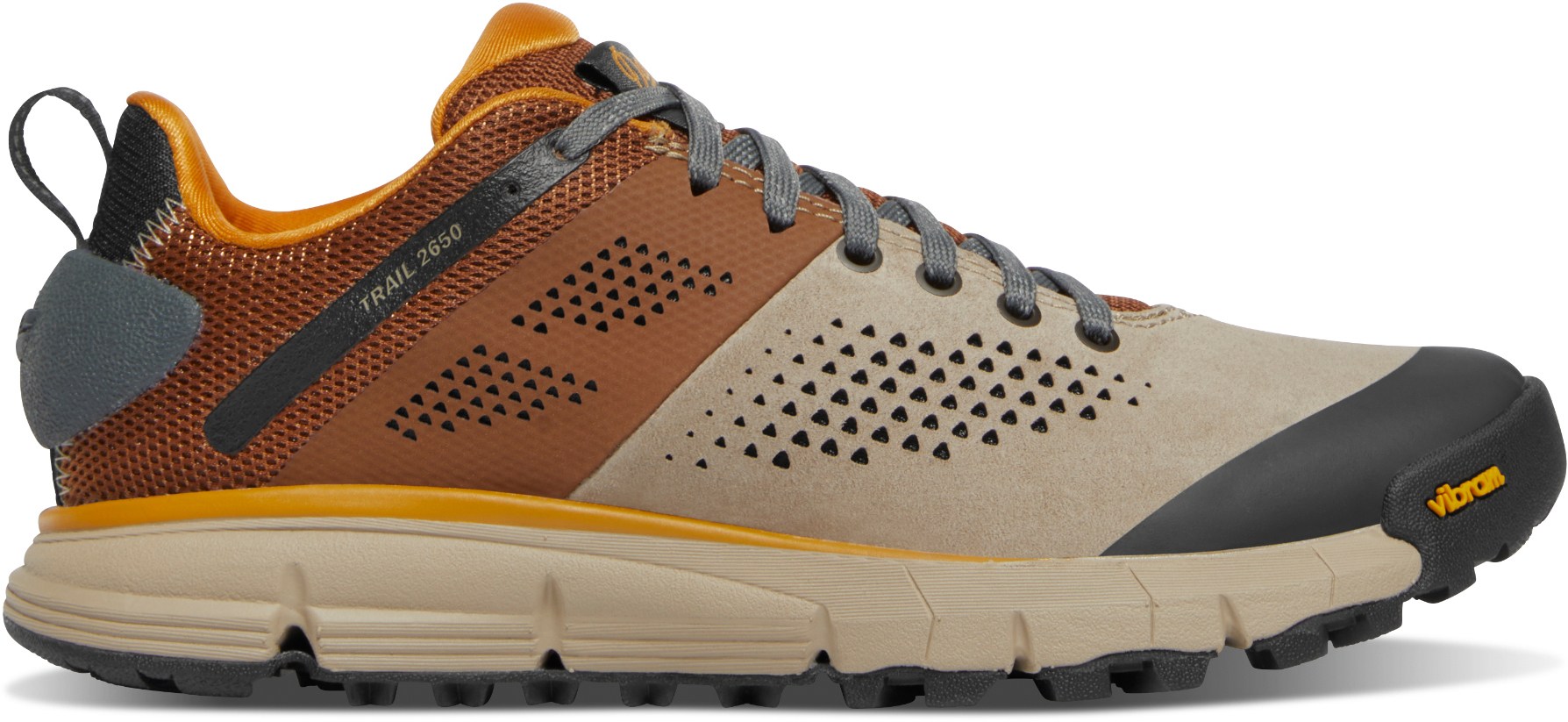
Category: Hiking shoe
Weight: 1 lb. 2 oz.
Waterproof: No (available)
What we like: Light and nimble without sacrificing protection or traction; high on style points.
What we don’t: Expensive, ungainly heel counter, and not the most stable shoe here.
Danner originally was known for its work boots, but the long-time footwear brand has made a nice transition to hikers of late. And the running shoe-inspired Trail 2650 is clear about its intentions: with the mileage of the Pacific Crest Trail in its name, this shoe is designed to tackle some serious ground. The Trail 2650 is comfortable right out of the box, grippy with a Vibram outsole, and competitively light (especially for a partial-leather design) at 1 pound 2 ounces per pair. Finally, it manages to do what most hiking shoes don’t: look good in the process. All in all, we’re impressed with the direction that Danner is headed, and the Trail 2650 lineup has received rave reviews (from us included) since its release a few years back.
The version of the Trail 2650 included here isn’t waterproof, but Danner also makes a GTX model for $190 and 1 pound 5 ounces per pair, along with a Mid GTX ($200) for those who want more ankle protection. It’s also worth noting the Danner Trail 2650 Campo—our favorite design for hot-weather hiking—which tones down the rubber heel counter (one of our nitpicks with the standard model), adds a lightweight mesh liner and sock-like construction, and knocks $10 off the price. Don’t expect a high level of stability from any of the shoes in the Trail 2650 series—we hesitate to wear them with a heavy pack—but for day hiking and ultralight backpacking, they’re solid all-rounders that are built to last…
10. Hoka Anacapa 2 Low GTX ($180)
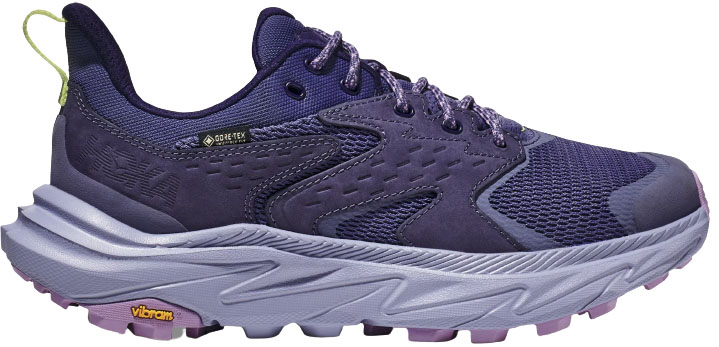
Category: Hiking shoe
Weight: 1 lb. 8.8 oz.
Waterproof: Yes (non-GTX available)
What we like: Extremely comfortable; great lacing system and fit; smooth ride.
What we don’t: Some outsole durability issues and polarizing looks.
The Hoka Speedgoat above has achieved legendary status among hikers (specifically the thru-hiking community), but there are some notable trade-offs with the trail-running design. For those who want a bit more support and protection, Hoka also offers an impressive lineup of hiking-specific footwear, including the Anacapa 2 Low here. The Anacapa (also available in a mid-height version) features Hoka’s well-known springy midsole, a rockered shape for a smooth ride on the trail, and a beefed-up construction that includes durable nubuck leather and a Gore-Tex waterproof liner. The result is a fast-moving shoe that nicely mixes a trail runner-like feel with the added structure of a hiker.
The Anacapa was recently updated with a focus on more sustainable materials, along with a few noteworthy changes to the midsole and upper. With a less intrusive heel counter, additional tongue padding, and slightly softer midsole, the 2 is arguably more comfortable than the outgoing version, and Hoka also enhanced the toe box for more durability and protection. However, we were surprised to see that the Vibram Megagrip outsole remains virtually unchanged—like the original, it features large sections of blown rubber that are susceptible to damage from rocky trail use. But the Anacapa 2 nevertheless is a solid update to a very good hiking shoe, and it’s especially ideal for those who stick to established trails and prioritize cushy comfort. For a more breathable design for summer hiking, check out the non-waterproof Anacapa Breeze Low ($155).
11. Topo Athletic Traverse ($150)
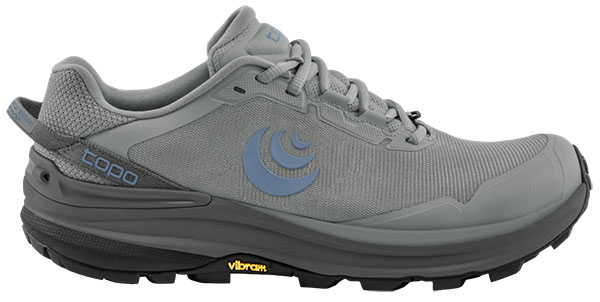
Category: Hiking shoe
Weight: 1 lb. 1.4 oz.
Waterproof: No
What we like: All the benefits of a trail runner with added durability, support, and protection.
What we don’t: Noticeably stiffer than many other thru-hiker favorites; wide toe box and snug midfoot won’t work for all feet.
Topo Athletic might not be a household name like Salomon or Merrell, but their lineup of trail shoes speaks for itself—not to mention, they’re founded by the former CEO of Vibram. The Traverse is the newest shoe in Topo’s collection, designed specifically for the long-distance thru-hiking community. Durability and protection are two clear highlights of the design, including a tightly woven, abrasion-resistant mesh upper and rock plate to protect against harsh impacts underfoot. Along with a tacky and aggressive Vibram Megagrip outsole, the Traverse stands out as a notably more confidence-inspiring companion than the also-thru-hiker-friendly Speedgoat and Lone Peak above or Brooks Cascadia below when the going gets technical. Weight is competitive, too, with the Traverse checking in at the lighter end of the grouping.
Both Altra and Topo Athletic shoes have become popular among thru-hikers for their roomy toe boxes, which encourage natural toe splay and accommodate swelling during long stints on the trail. But while Altra’s zero-drop designs can feel a bit sloppy, especially on challenging ground, the Traverse offers a much more high-performance feel with a snugger fit (particularly around the midfoot) and a 5-millimeter drop. It’s also noticeably stiffer, which led to some foot soreness in testing—if plush comfort is a priority, Topo’s own Ultraventure 3 is a sizable step up and more responsive than the Lone Peak, in our experience. A final nitpick is that the Traverse is only available in a single drab colorway. But these complaints do little to detract from the shoes’ light but planted feel on technical ground—great for long-distance hikers who want or need some added structure.
12. Arc’teryx Aerios GTX ($180)
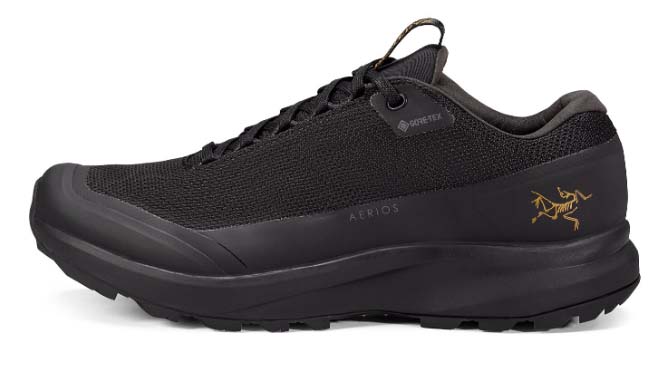
Category: Hiking shoe
Weight: 1 lb. 4 oz.
Waterproof: Yes (non-GTX available)
What we like: Light, tough, and extremely well built.
What we don’t: Pricey; short lugs give up a little traction on wet and soft terrain.
We’ve learned to count on Arc’teryx for premium and sleek-looking designs, and their Aerios GTX is no exception. Now in its second iteration, this shoe is one of the Canadian brand’s biggest success stories of late, combining the comfort and light weight of a trail runner with the protection and stability of a hiking shoe. It’s incredibly nimble at just 1 pound 4 ounces per pair, waterproof with a Gore-Tex membrane, and tough with a burly toe cap and a large swath of TPU around the bottom portion. What’s more, the current iteration features a 100%-recycled polyester upper, which has proven itself to be just as durable as the first model’s Cordura. For these reasons, it’s our favorite pair of Arc’teryx hiking footwear to date.
We tested the Aerios on a multi-day backpacking trip in Washington’s Cascade Range, which included technical trails and hiking with a loaded pack. The shoe was immediately comfortable, although the updated (wider) last was almost too roomy for our average-sized foot—if you’ve worn Arc’teryx footwear in the past, take note that the Aerios offers a much more accommodating fit. In terms of traction, the shoe is in its element on rock but lags behind some models we’ve tested on wet terrain like mud and snow. Minor gripes aside, it’s a premium piece of footwear for everything from speedy day missions to week-long treks in the mountains. And for a more breathable option for hot summer hiking, Arc’teryx also makes the non-waterproof Aerios Aura ($150).
13. Scarpa Rush 2 GTX ($199)
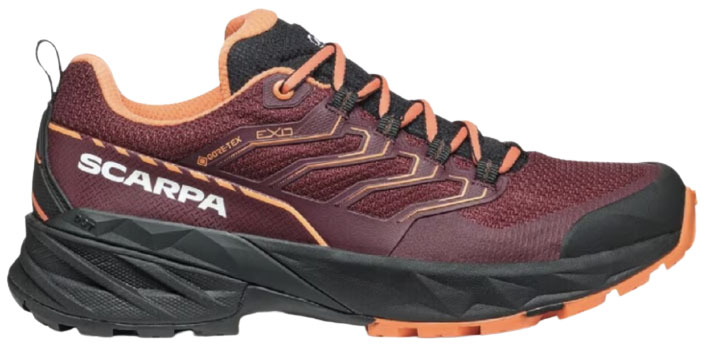
Category: Hiking shoe
Weight: 1 lb. 6.2 oz.
Waterproof: Yes
What we like: Trail runner-like agility with a boost in protection and stability.
What we don’t: Expensive; not as light as trail runners like the Speedgoat and Lone Peak above.
The hiking-shoe-meets-trail-runner love story has been unfolding for a number of years, and Scarpa’s Rush 2 GTX is a prime example. With the cushion and rocker of a trail runner alongside the stability and protection of a hiking shoe, the Rush is a best-of-both-worlds option for modern hikers. Specifically, you get a durable fabric upper with welded reinforcements, burly midsole with EVA foam and TPU reinforcements for cushion and stability, and a sticky, rockered outsole that facilitates quick movements. All told, if you’re considering a trail runner but are wary of giving up the support and hardwearing nature of a hiking shoe, the Rush 2 GTX (also offered in a mid-height version) is well worth a look.
We wore the first-generation Scarpa Rush while trekking in southern Patagonia and were impressed with its prowess on everything from hardpacked trail to talus and smooth rock. Our main gripe was the shoe’s low collar and poor ankle lock; thankfully, the 2 offers a noteworthy improvement with increased stability and torsion control at the rear. And while the Rush is significantly heavier than trail runners like the Speedgoat and Lone Peak above (read: not ideal for running), it does feel lighter than its weight would suggest (and in a side-by-side test, the original version was notably more cushioned than the Salomon X Ultra 4). Finally, the Scarpa is pricey at $199. But for speed-focused hikers and fastpackers, it’s hard to knock the purpose-built design, which offers a nice boost in stability and protection compared to standard trail running shoes.
14. Brooks Cascadia 17 ($140)
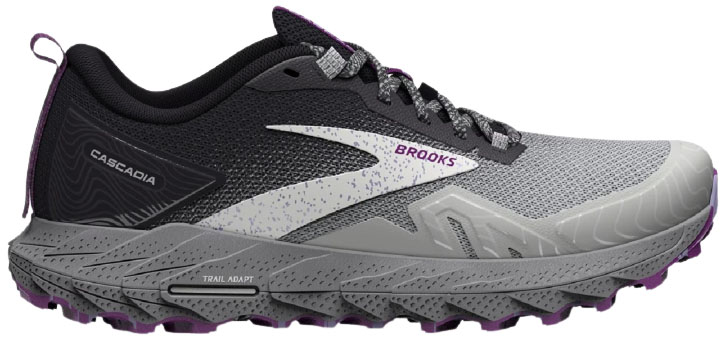
Category: Trail runner
Weight: 1 lb. 3.6 oz.
Waterproof: No (available)
What we like: A classic thru-hiking shoe that offers a bit more stability than the Speedgoat above.
What we don’t: Fairly dated and fit will be too roomy for some.
Now in its 17th iteration, the Brooks Cascadia is one of the longest-standing trail runners on the market and particularly popular in the thru-hiking community. Like the Speedgoat and Lone Peak above, this shoe bridges the gap for speed-focused hikers with the support and protection you need for rugged trails alongside a hefty dose of cushioning for long days out. And at only 1 pound 3.6 ounces for the pair, it won’t weigh you down as much as the hiking-specific shoes here. We took the recently updated 17 on a backpacking trip through Washington’s Necklace Valley and were impressed with its balanced design: The Cascadia felt stable and precise while traversing off-camber terrain but remained impressively quick and responsive when running the vehicle shuttle at the end of the trek.
How does the Cascadia compare with another darling of the thru-hiking world, the Altra Lone Peak above? Both offer a nice array of trail-ready features like aggressive rubber outsoles and attachment points for gaiters, and the Brooks tacks on drainage ports in the upper. They also feature roomy toe boxes that are great for accommodating swollen toes, but the Cascadia locks things down more at the midfoot and heel for a more performance-oriented fit. And the key difference is the Cascadia’s 8-millimeter drop compared to the Lone Peak’s zero-drop shape, which lends a more agile and quick overall feel. For a similarly built design with an even more agile personality, Brooks’ own Catamount 3 is another staff favorite. A bit lighter (1 lb. 0.8 oz.) and more padded (by 2mm at the forefoot and 4mm at the heel) than the Cascadia, the Catamount is both cushier and more responsive. In the end, we think the Cascadia is the best all-rounder for most hikers, although the Lone Peak and Catamount have their place.
15. Salomon XA Pro 3D V9 GTX ($160)
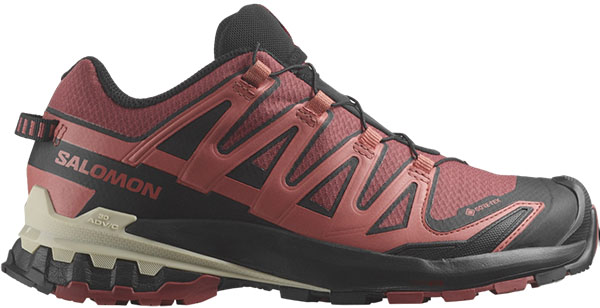
Category: Hiking shoe/trail runner
Weight: 1 lb. 6.2 oz.
Waterproof: Yes (non-GTX available)
What we like: Lighter and more cushioned than the X Ultra—overall a better fit for easy trails.
What we don’t: Outdated feel; lacks the protection and stability most will want on technical terrain.
Salomon bills its XA Pro 3D as a trail running shoe, but it’s arguably best suited for day hikes and overnights on easy-to-moderate terrain. Now in its ninth iteration, the XA Pro 3D features a well-padded tongue and collar, and the Quicklace system creates a snug and secure hold around the foot. Despite its running focus, protection is also surprisingly good thanks to a large and burly toe cap, rigid heel cup, and solid 3D Advanced chassis. Finally, the GTX version here features a reliable waterproof membrane that will keep most moisture at bay (it’s also sold without Gore-Tex for $140). Added up, you get the comfort and weight of a running shoe with the traction, durability, and protection of a hiker—a very competitive combination for hikers and backpackers carrying loads of around 35 pounds or less.
Compared to the X Ultra above, the XA Pro is a bit more cushioned and not quite as stiff underfoot, making it a better fit for smooth trails but less stable on technical terrain or when shuttling a heavier pack. We also found that it feels a little outdated and unpolished along the interior, which is especially noticeable when worn back-to-back with more modern designs like the Speedgoat. And finally, the XA Pro is pretty thin at the top—we once snagged a root and it went straight through the mesh—and not everyone will love the Quicklace system, which has a tendency to gather fabric in weird ways and create pressure points along the top of the foot. But the XA Pro is nevertheless a reliable staple of the hiking footwear market and fits the bill for recreational hikers who stick to the trail.
16. La Sportiva TX4 Evo ($169)
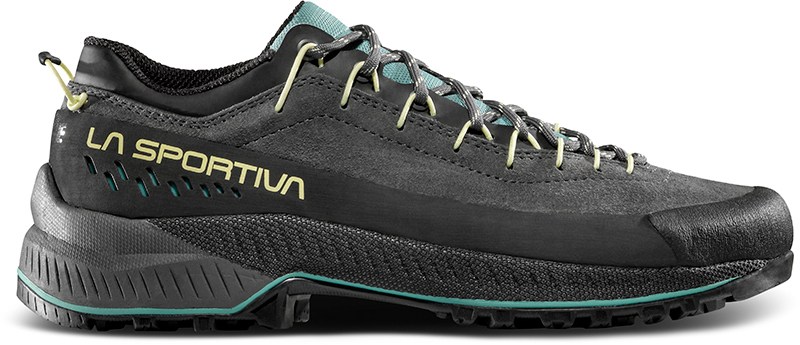
Category: Approach shoe
Weight: 1 lb. 12.4 oz.
Waterproof: No
What we like: Excellent grip on rock and stiff construction for rocky terrain; the latest Evo model has a nice sustainability slant.
What we don’t: Too stiff and clunky for easy trails; considerably heavier than the original TX4.
The La Sportiva TX4 Evo isn’t a hiking shoe per se, but it’s nevertheless well deserving of a mention here. Designed as an approach shoe for climbers who routinely head off trail, it’s a fantastically tough and capable shoe that shines on challenging, mountainous terrain. A sticky Vibram sole means you get confidence-inspiring traction on rock, and the generous rubber rand and stiff midsole provide critical protection and stability while boulder-hopping or scrambling up slabs. To top it off, we’ve been particularly blown away by the TX4’s leather upper, which has withstood an incredible amount of abuse with no signs of wearing down (you’ll likely need a resole long before the upper starts to deteriorate).
It’s always risky business updating a legendary shoe like the TX4, and we have mixed feelings about the latest TX4 Evo. While we’re still in the process of testing the new design, there are some substantial changes worth pointing out: In addition to a sizable 7.6-ounce weight penalty (per pair), the TX4 Evo replaces the dotty tread of the original with diamond-shaped lugs, although the sticky “climbing zone” at the forefoot remains. La Sportiva also upped the sustainability focus with recycled materials and a new platform that can be resoled to maximize the shoes’ lifespan—both positive changes, in our opinion. Updates aside, the TX4 still wouldn’t be our first choice as a dedicated trail shoe: It’s stiffer than most hiking shoes (especially when compared to trail runners like the Speedgoat and Cascadia above), lacks some bite in dirt and soft ground, and has a roomy toe box that may not work for some narrow-footed hikers. In the end, the Ultra Raptor II above is a better all-rounder in all these categories…
17. Aku Rocket DFS GTX ($190)
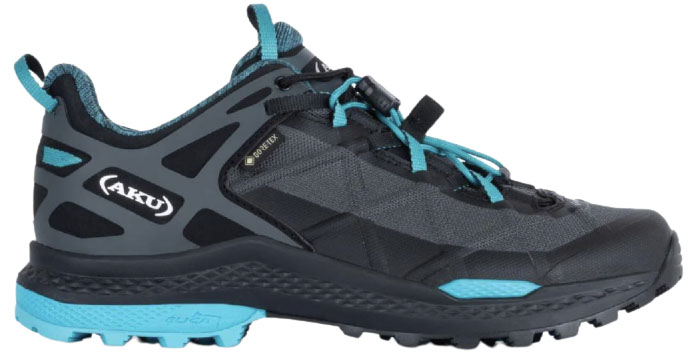
Category: Hiking shoe/trail runner
Weight: 1 lb. 5.9 oz.
Waterproof: Yes
What we like: Standout durability, protection, and traction in a light and agile package.
What we don’t: Expensive, stiff collar, and runs warmer than most competitors.
Aku is an Italian footwear brand with a wide selection of technical, mountain-ready designs, and they’ve recently entered the fast-and-light space. While the majority of their offerings are mid-height boots or burly approach shoes, the Rocket is a versatile lightweight hiker with a nimble and energetic feel. But don’t get us wrong—this is no flimsy trail runner. With a full rubber rand, solid heel and toe caps, Vibram Traction Lug outsole, and hardwearing upper with laminated overlays, the Rocket is a capable all-terrain vehicle that can handle heavy loads and cross-country travel with aplomb.
Like the La Sportiva Spire GTX and Ultra Raptor above, the Rocket is worth considering if your adventures take you into mountainous terrain. On the flip side, the shoe might feel overkill on easy trails: It’s relatively heavy at a listed 1 pound 5.9 ounces (our women’s size 9 checked in at 1 lb. 9.4 oz.), the durable upper and waterproof membrane detract from breathability, and the dual-lace design feels and looks busy. We’ve also found the cuff to be relatively stiff and snug-feeling, and it hasn’t softened over time. But the Rocket nevertheless packs a lot of punch for such an agile design, and is a stable, grippy, and protective option for those looking to level up from one of the lightweight trail runners here…
18. Keen Targhee IV Vent ($145)
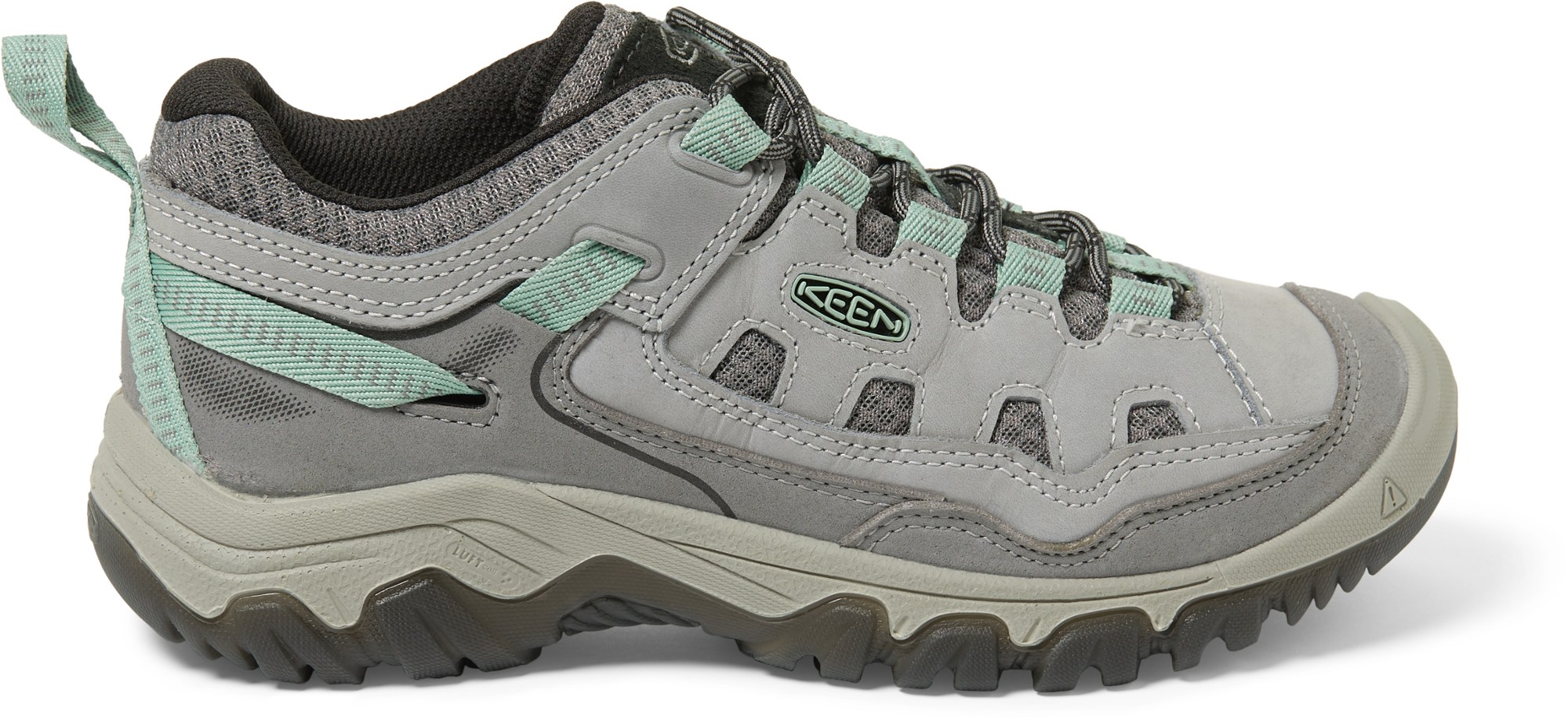
Category: Hiking shoe
Weight: 1 lb. 13.1 oz.
Waterproof: No (available)
What we like: A durable trail workhorse.
What we don’t: Pricier than the Merrell Moab above without enough to show for it.
Keen’s Targhee IV Vent is a classic hiking shoe that goes head-to-head with designs like Merrell’s Moab 3 above. The leather upper and sturdy outsole aren’t particularly lightweight (especially compared to modern trail runner-inspired designs), but the benefits are excellent stability over rough terrain, great long-term durability, and impressive all-around protection for your foot. The Targhee also boasts a noticeably wide toe box, which is great for accommodating swollen feet and a nice alternative to some of the narrower designs here. If you’re in the market for a leather hiking shoe, Keen’s Targhee Vent is certainly worth adding to your list.
Among traditional day hiking options, the Keen Targhee IV Vent and Merrell Moab 3 are two of the most popular shoes on the market. Both are very comfortable right out of the box, offer plenty of support and traction for non-technical trails, and can even get the job done on shorter backpacking trips. But while the Targhee’s nubuck leather upper is a little more durable than the mesh used on the Moab, we’re not sure it’s worth the $25 bump. Further, within this price class, the Keen contends with more modern designs like the Salomon X Ultra 4 above, which offers a closer fit and better performance overall. And with the latest update, weight jumped a considerable 4.4 ounces per pair, although the Targhee’s new polyurethane midsole is designed to boost underfoot protection and compress less over time. We’re in the process of testing the latest version and will report back with our findings. For those who frequently hike in wet climates like the Pacific Northwest, the design also comes in a waterproof version for $155.
19. Adidas Terrex AX4 ($100)
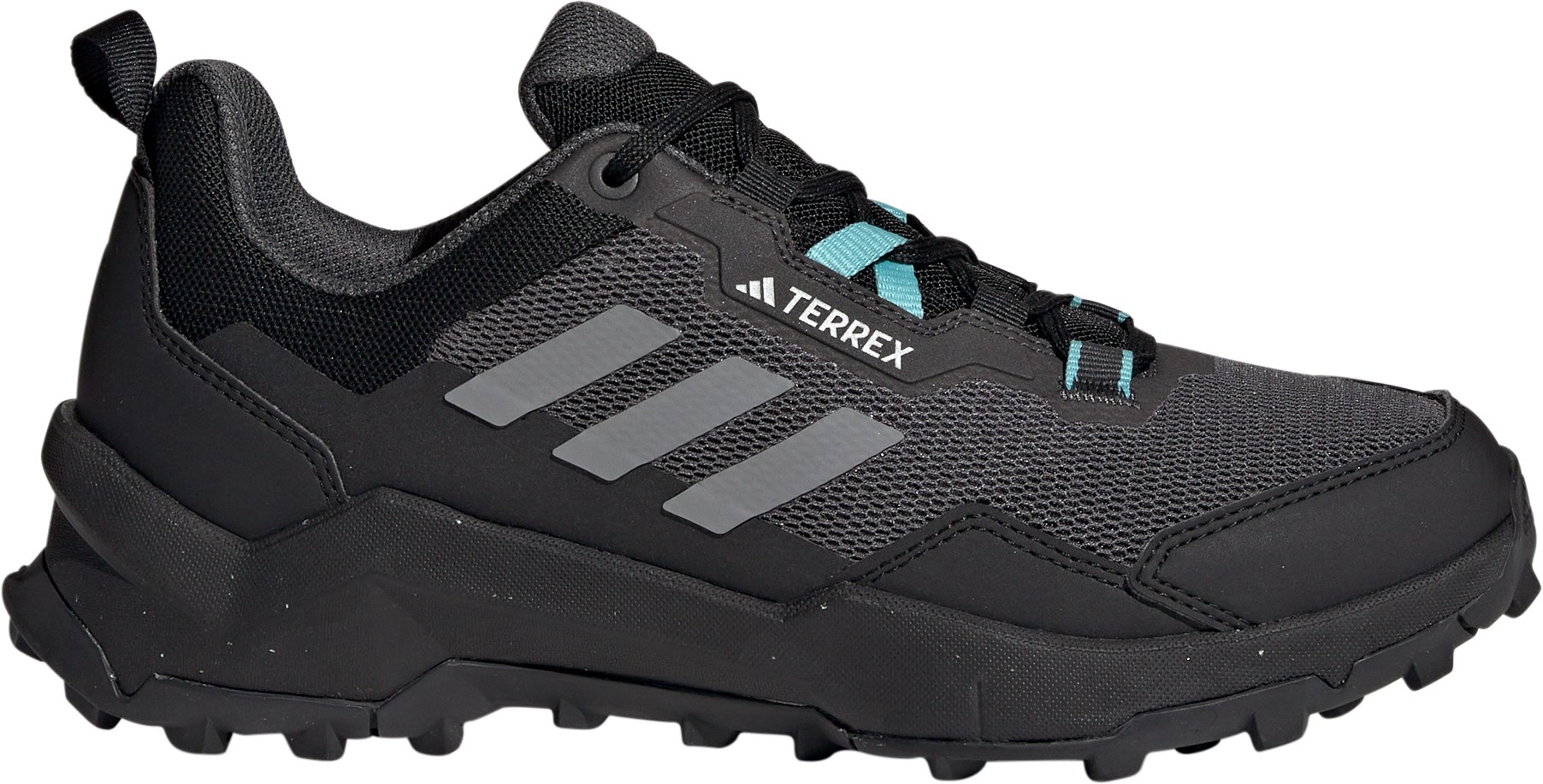
Category: Hiking shoe
Weight: 1 lb. 6.2 oz.
Waterproof: No (available)
What we like: Grippy and tough at a fantastic price.
What we don’t: Limited toe protection and cheap insole.
Adidas has expanded its Terrex hiking footwear line substantially in recent years, and the AX4 is their well-rounded budget offering. At just $100 for the non-waterproof version—$20 less than the Moab above—you get excellent traction from the Continental-brand outsole, a durable upper, and a simple but effective lacing system. On lengthy and challenging hikes in southern Patagonia, we found the shoe surprisingly adept: Its light weight and low-profile midsole make it easy to trust when scrambling, and there’s sufficient cushioning to isolate you from rocks and roots. As a day hiking option, the Terrex AX4 has a lot going for it.
Unsurprisingly, there are a few compromises in the AX4’s affordable build. First and foremost is the lack of a proper toe cap, which we got a few painful reminders of when catching rocks on the trail. Additionally, the insole is cheap, thin, and seems to hold stink more than a higher-end OrthoLite design. Finally, while comfort is quite good considering the price, spending up for a shoe like the Merrell Moab Speed above will get you a softer interior and springier cushioning. In the end, high-mileage users may want to look elsewhere, but the AX4’s combination of price and performance earns it an entry on our list this year.
20. On Cloudwander Waterproof Low ($180)
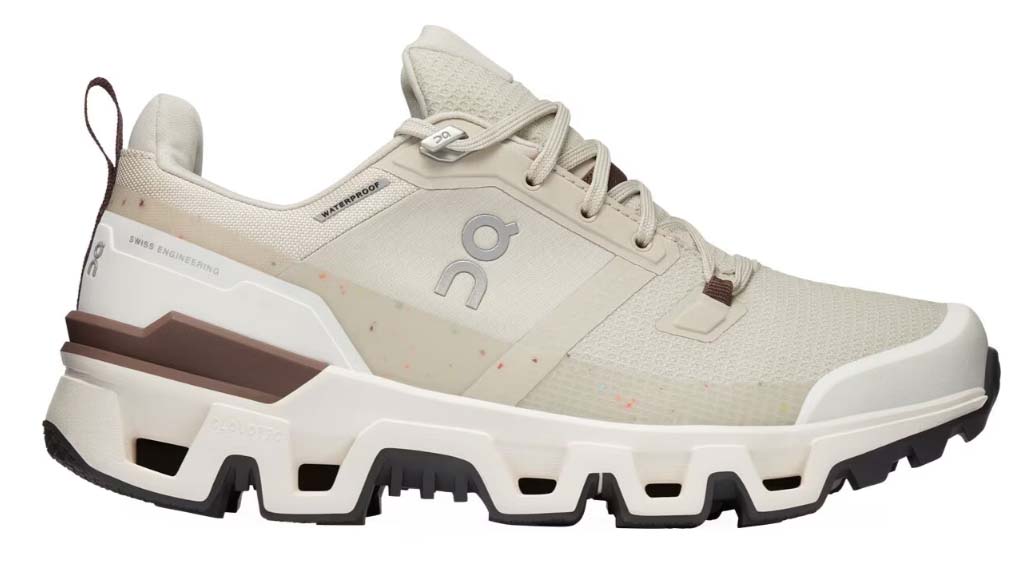
Category: Hiking shoe
Weight: 1 lb. 6.6 oz.
Waterproof: Yes
What we like: Good support, stability, and protection in a quick-moving design.
What we don’t: Stiff, narrow, and pricey; outsole accumulates debris and mud.
Best known for their distinctive outsole, Swiss running brand On recently entered the hiking market with a small selection of trail-ready designs, including the Cloudwander Waterproof. The Cloudwander combines the stability and protection of a hiking shoe with the agility of a running shoe, featuring a noticeable toe rocker that encourages an easy stride alongside generous toe and heel protection and burly TPU overlays throughout. You also get decent waterproofing by way of On’s in-house waterproof membrane. And unlike many of the shoes above, the Cloudwander’s sleek and modern design crosses over well for around-town use, too.
But while On claims their CloudTec cushioning to be comfortable for all-day wear, that wasn’t our experience with the shoe. We took the Cloudwander both day hiking and backpacking—on easy trails and over cross-country terrain—and found it to be fairly stiff and unforgiving underfoot. What’s more, the outsole channels had a tendency to accumulate debris and mud, flinging it onto our hiking pants with each step. And while the reinforced upper will hold up to a lot of abuse, we do have durability concerns with the outsole, which packed out significantly during our short week of testing. That’s a lot of gripes for such a high-priced shoe—unless you’re willing to spend up for the On’s style, the picks above provide better performance at a lower price… Read in-depth review
See the On Cloudwander Waterproof Low
Women’s Hiking Shoe Comparison Table
| SHOE | PRICE | CATEGORY | WEIGHT | WATERPROOF | UPPER |
|---|---|---|---|---|---|
| Merrell Moab Speed 2 | $140 | Hiking shoe | 1 lb. 3.4 oz. | No (available) | Synthetic/TPU |
| Hoka Speedgoat 5 | $155 | Trail runner | 1 lb. 1 oz. | No (available) | Mesh |
| Merrell Moab 3 | $120 | Hiking shoe | 1 lb. 9.1 oz. | No (available) | Leather/mesh |
| La Sportiva Spire GTX | $209 | Hiking shoe | 1 lb. 10.2 oz. | Yes (Gore-Tex) | Mesh |
| La Sportiva Ultra Raptor II | $149 | Trail runner/hiking shoe | 1 lb. 4.8 oz. | No | Mesh |
| Altra Lone Peak 8 | $140 | Trail runner | 1 lb. 2.3 oz. | No (available) | Synthetic/mesh |
| TNF Vectiv Fastpack Futurelight | $149 | Hiking shoe | 1 lb. 3.2 oz. | Yes (Futurelight) | Mesh |
| Salomon X Ultra 4 GTX | $160 | Hiking shoe | 1 lb. 9.6 oz. | Yes (Gore-Tex) | Synthetic |
| Danner Trail 2650 | $170 | Hiking shoe | 1 lb. 2 oz. | No (available) | Leather/mesh |
| Hoka Anacapa 2 Low GTX | $180 | Hiking shoe | 1 lb. 8.8 oz. | Yes (Gore-Tex) | Leather |
| Topo Athletic Traverse | $150 | Hiking shoe | 1 lb. 1.4 oz. | No | Synthetic |
| Arc’teryx Aerios GTX | $180 | Hiking shoe | 1 lb. 4 oz. | Yes (Gore-Tex) | Synthetic |
| Scarpa Rush 2 GTX | $199 | Hiking shoe | 1 lb. 6.2 oz. | Yes (Gore-Tex) | Mesh |
| Brooks Cascadia 17 | $140 | Trail runner | 1 lb. 3.6 oz. | No (available) | Synthetic |
| Salomon XA Pro 3D V9 GTX | $160 | Hiking shoe/trail runner | 1 lb. 6.2 oz. | Yes (Gore-Tex) | Synthetic |
| La Sportiva TX4 Evo | $169 | Approach shoe | 1 lb. 12.4 oz. | No | Leather |
| Aku Rocket DFS GTX | $190 | Hiking shoe | 1 lb. 5.9 oz. | Yes (Gore-Tex) | Synthetic |
| Keen Targhee IV Vent | $145 | Hiking shoe | 1 lb. 13.1 oz. | No (available) | Leather |
| Adidas Terrex AX4 | $100 | Hiking shoe | 1 lb. 6.2 oz. | No (available) | Mesh |
| On Cloudwander Waterproof Low | $180 | Hiking shoe | 1 lb. 6.6 oz. | Yes (in-house) | Mesh/TPU |
About Our Testing Process
Hiking shoes come in all shapes and sizes, from burly leather designs for overnight backpacking with a full load to trail runners that have been adopted by long-distance thru-hikers who care more about weight than underfoot support. To supplement our unisex hiking shoe round-up, former senior editor Jenny Abegg put together our initial list of 19 women’s-specific designs in early 2022. An accomplished mountain runner based in the Pacific Northwest, Jenny’s ideal day starts and ends wearing a headlamp and gets her as far off the beaten path as possible. Contributing editor Maggie Slepian took over the guide in 2024, using her decade of technical gear testing and numerous thru-hikes to refine the list.
Our current lineup of 20 women’s hiking shoes is the result of our collective experiences both on and off the trail, along with feedback from our network of female testers and the online hiking community. As women who spend a lot of time outside, we’re intimately familiar with the plight of finding well-fitting shoes that are comfortable to wear all day, effectively balance weight and underfoot stability, and hold up well over time (there’s always a trade-off). When we test hiking shoes, we take them on everything from mellow day hikes to multi-day backpacking trips, paying close attention to the amount of padding underfoot, the level of grip on various types of terrain, and the quality of everything from the hardware and laces to the upper and outsole. We also consider protection—both at the front of the shoe and underfoot—as well as breathability and overall fit. As we continue testing, we’ll add and remove options above depending on their performance.
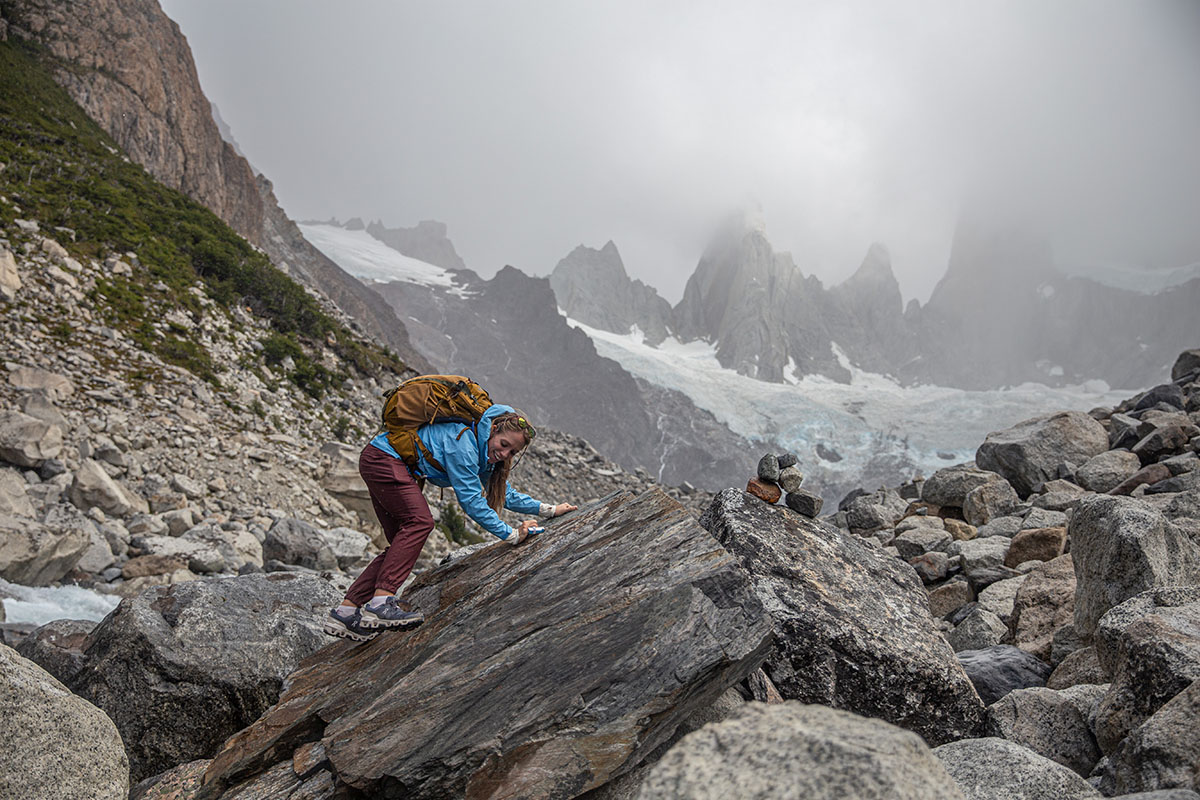
Women’s Hiking Shoe Buying Advice
- Women’s-Specific Hiking Shoes
- Hiking Footwear Types
- Weight
- Stability and Support
- Waterproofing
- Breathability
- Lacing Systems
- Upper Materials
- Midsoles: EVA Foam and TPU
- Outsoles and Traction
- Toe Protection
- Sustainability
- Hiking Shoes vs. Hiking Boots
Women’s-Specific Hiking Shoes
In 2024, the vast majority of hiking shoes come in both men’s and women’s versions. In general, women’s shoes are designed to fit narrower heels and higher arches, come in women’s-specific sizes and widths, and are offered in a different set of colorways. There are also a few hiking shoes that were designed specifically with women in mind, including the Oboz Sapphire, Keen Terradora, and Merrell Siren Edge. While the majority of our female friends wear women’s shoes, it’s important to note that some women might be better off opting for a men’s model (this is particularly important for those with high-volume feet). As with all clothing and footwear, your best bet is to try on before buying.
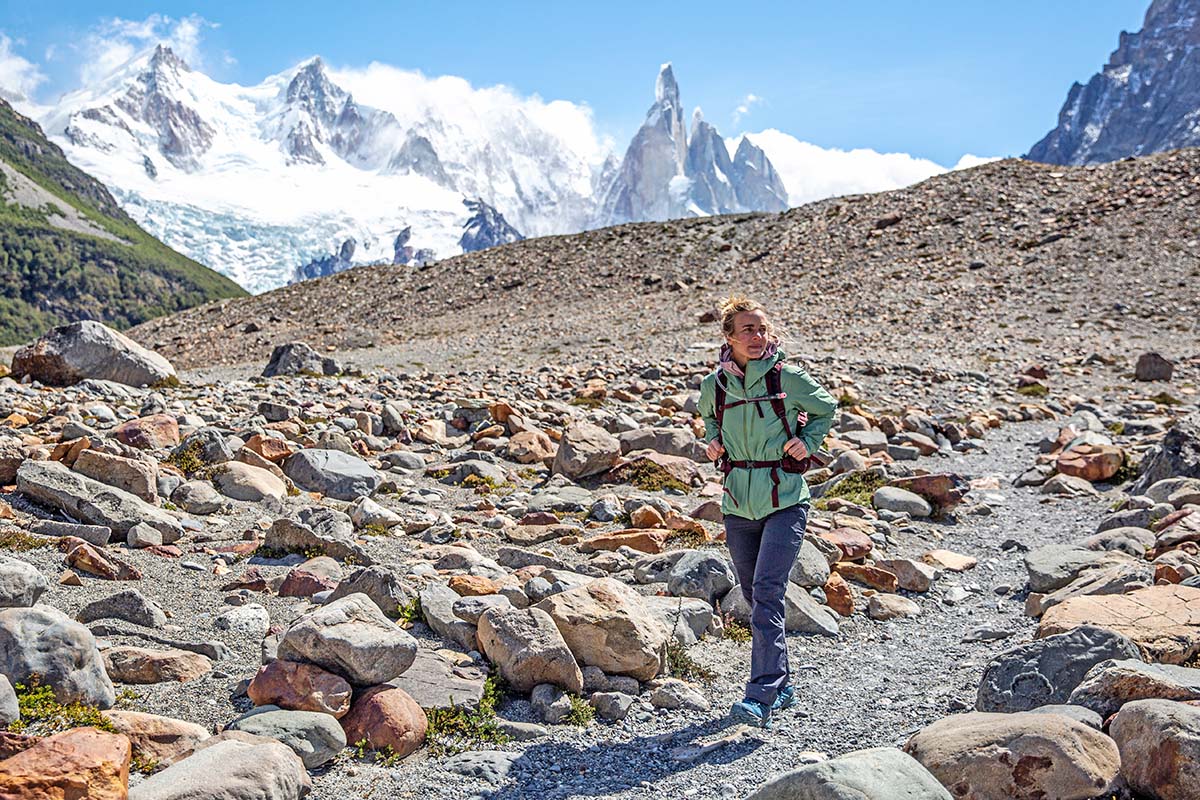
Hiking Footwear Types
Hiking Shoes
For most day hikers—and even a good number of backpackers and thru-hikers—a hiking shoe that falls just below the ankle is the perfect match. These shoes generally take on one of two forms: The majority are lightweight, trail-runner-inspired shoes like The North Face Vectiv Fastpack and Topo Athletic Traverse, while more traditional holdouts are leather designs reminiscent of a hiking boot (but with a low top), such as the Keen Targhee and Merrell Moab 3. Regardless of the style, most of these shoes offer ample stability, protection, and traction for tackling rough trails with a load by way of stiff midsoles and outsoles, toe caps, and reinforced uppers. Hiking shoes also are great options for folks needing a substantial shoe for daily wear—just be aware that the outsoles will wear faster on pavement.
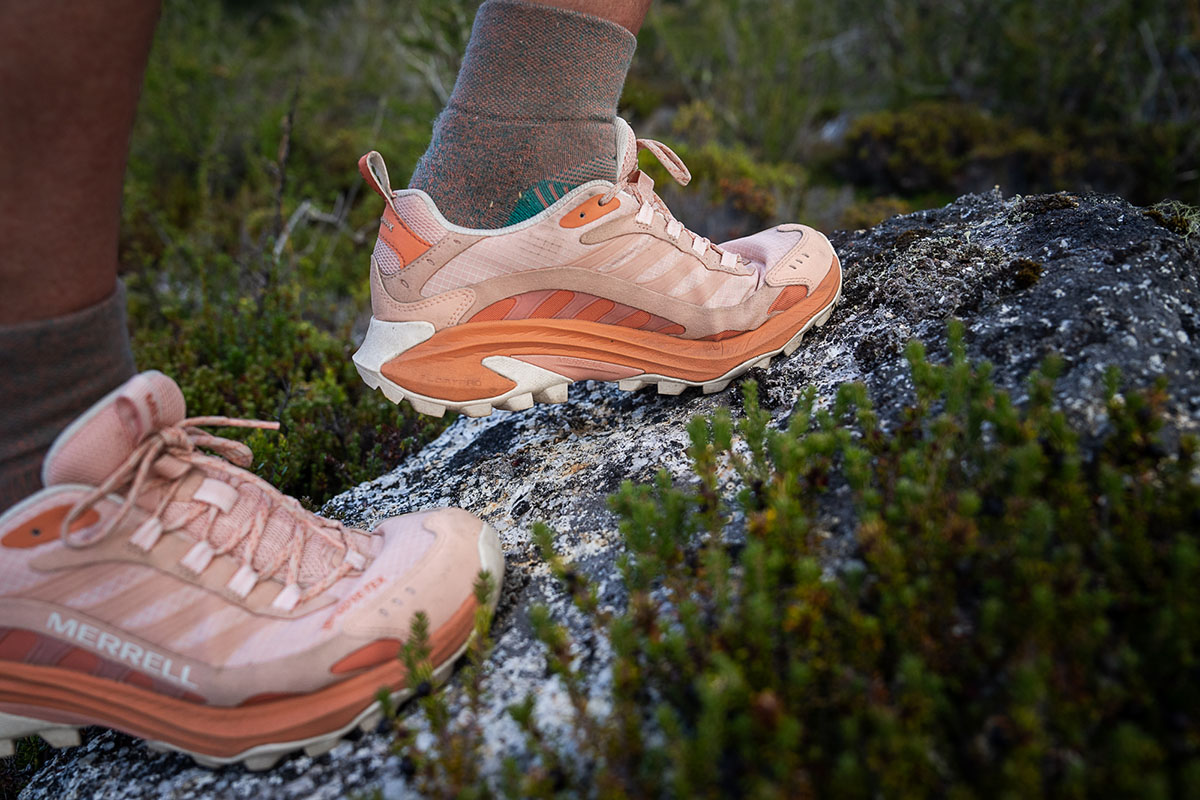
Trail Running Shoes
If moving fast trumps all else, we’d recommend a trail running shoe. These shoes, including the Hoka Speedgoat, Altra Lone Peak, and Brooks Cascadia are the ultimate lightweight option and beloved among thru-hikers on long trails like the PCT and AT. However, trail runners are really not intended as backpacking footwear: The flexible midsoles don’t provide much support on technical terrain or while carrying a heavy load, durability suffers, and you get very little toe and underfoot protection. But for easy day hikes or experienced backpackers, it’s hard to knock the comfort you get with a flexible build and cushioning underfoot. We include some great trail running and hybrid options here, but you can find more of our picks in our article on the best trail running shoes.
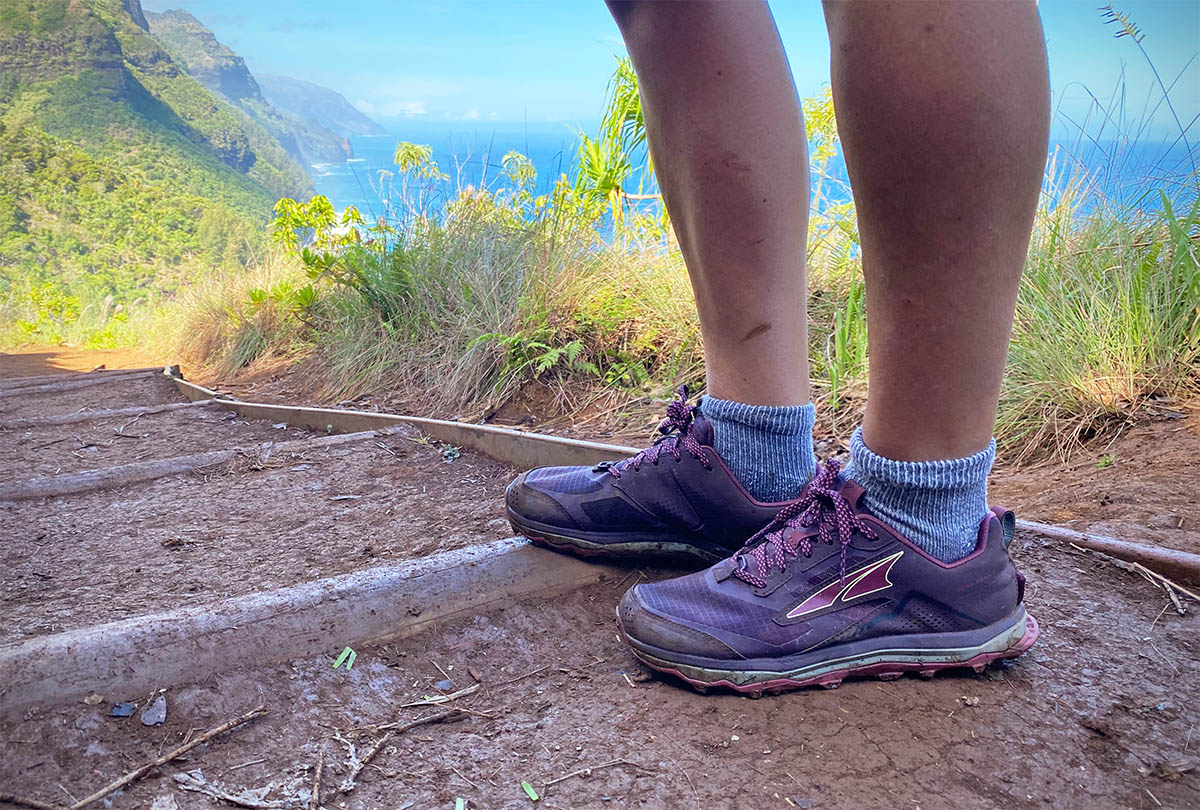
Approach Shoes
The third option has a relatively narrow focus: climbers or hikers who need a grippy shoe to tackle steep, rocky terrain (often part of the “approach” to a rock climb). Approach shoes are easy to spot: They have a large rubber toe rand, to-the-toe lacing, and a sticky, low-profile rubber compound underfoot for maximum grip on rock (look for shorter and more rounded lugs). These shoes can be plenty comfortable on day hikes but aren’t what we typically recommend as a daily driver: the tread isn’t as secure on muddy trails, and they’re stiffer than most hiking shoes, which will result in discomfort on high-mileage days. But if your hikes include a lot of scrambling or rock hopping, an approach shoe can be an excellent choice. We’ve included one model on this list (the La Sportiva TX4 Evo), but for a complete look at the market, check out our article on the best approach shoes.
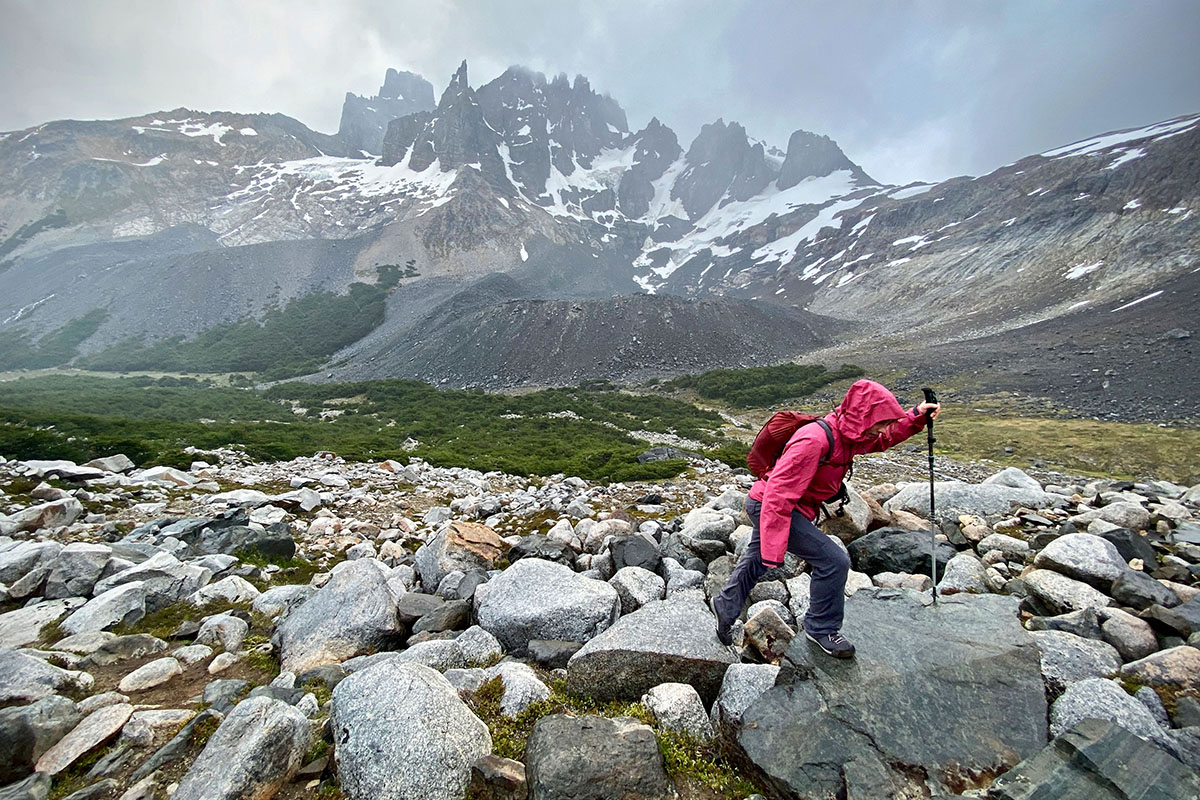
Weight
Over the past decade, one of the most significant advances in hiking shoes has been the move to lighter-weight designs. Tough but thin fabrics and the rising popularity of trail runners have made putting on major miles a lot easier. As a result, all of the shoes on our list weigh well under 2 pounds for the pair, with some dropping to just over 1 pound—by comparison, a traditional backpacking boot like the Asolo TPS 520 tips the scales at over 4 pounds. It’s true that the drop in ounces sometimes impacts long-term durability, but there are still a number of compelling options for traditionalists, including the leather Merrell Moab 3 and Keen Targhee line. But for most, a lightweight trail runner-inspired shoe is the best choice for day hikes, peak bagging, and quick overnight trips. As long as the rest of your gear is equally light, there are very few sacrifices.
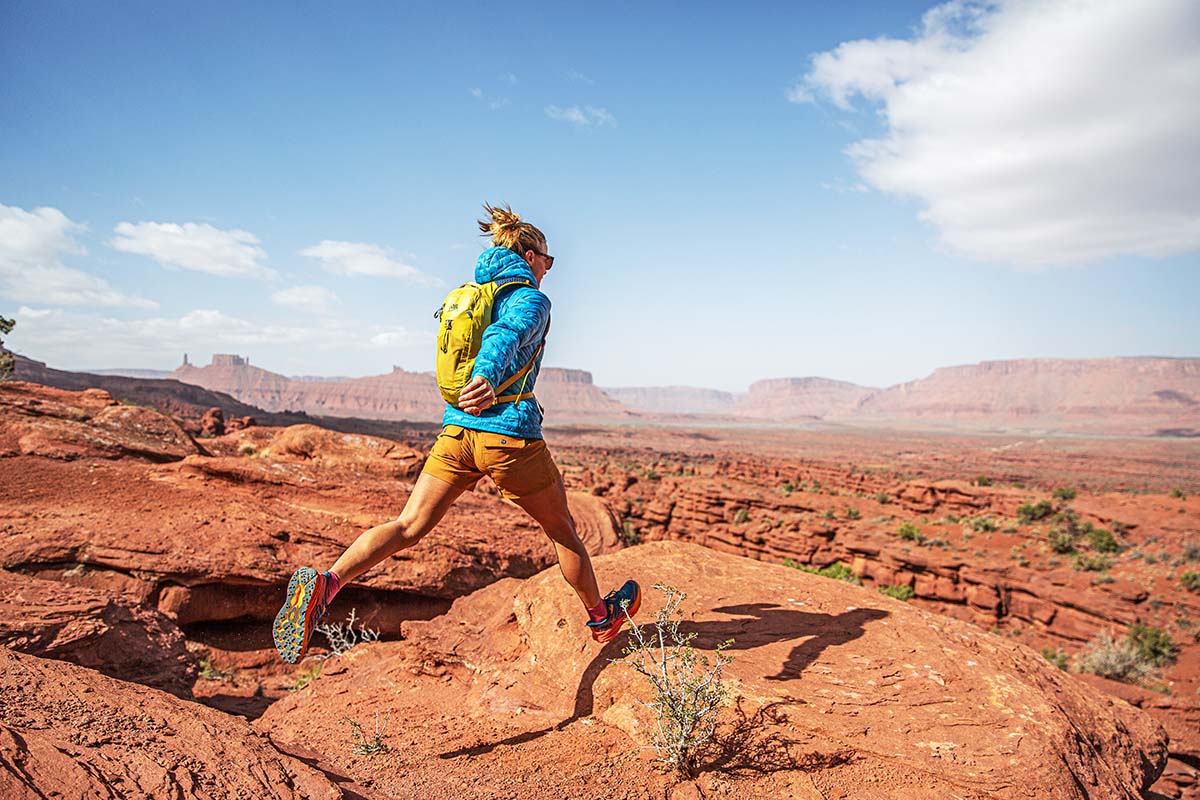
Stability and Support
Regardless of whether you’re opting for a new-school synthetic model or a more traditional leather hiker, most hiking shoes retain good stability and support thanks to robust uppers and midsoles and relatively rigid soles. For example, despite having the appearance of a trail runner, the Scarpa Rush 2 GTX incorporates a stiff TPU frame and a burly sole that prioritizes durability and stability. What’s more, hiking shoes offer solid protection with toe caps, generous rands, and burly nylon or leather uppers. Of course, you don’t get the added ankle support of a hiking boot, but most hiking shoes offer decent performance for tricky terrain or while carrying a load.
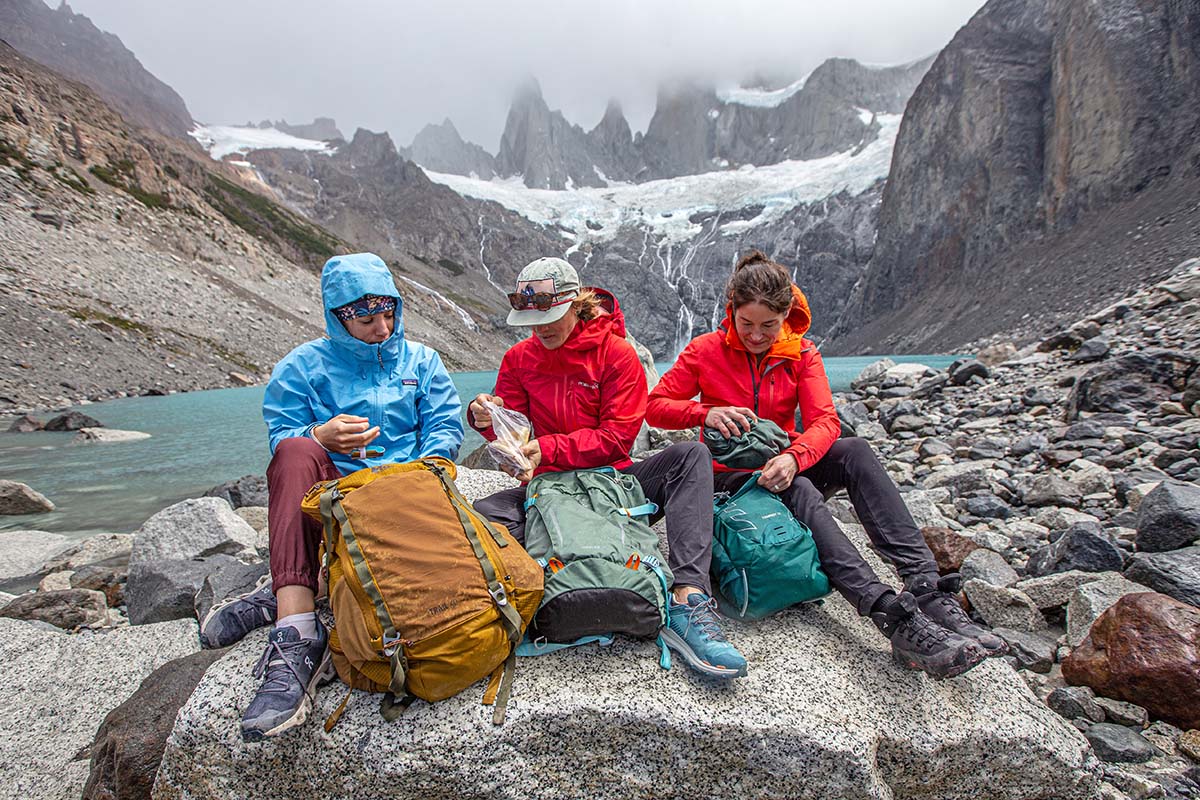
If you do choose to go with a lightweight trail runner, keep in mind that the trade-off is decreased stability and support. These shoes have more flexible midsoles, and the large dose of cushioning underfoot is great for comfort but offers less structure for off-camber sections of trail. The mesh upper of a trail runner also lacks around-the-foot protection and leaves your feet more vulnerable to roots and rocks. These are compromises that many day hikers (and well-conditioned backpackers) are willing to put up with for a more nimble, lightweight shoe. However, in most cases, we hesitate to recommend a trail running shoe for inexperienced hikers and difficult trails, including off-trail scrambling.
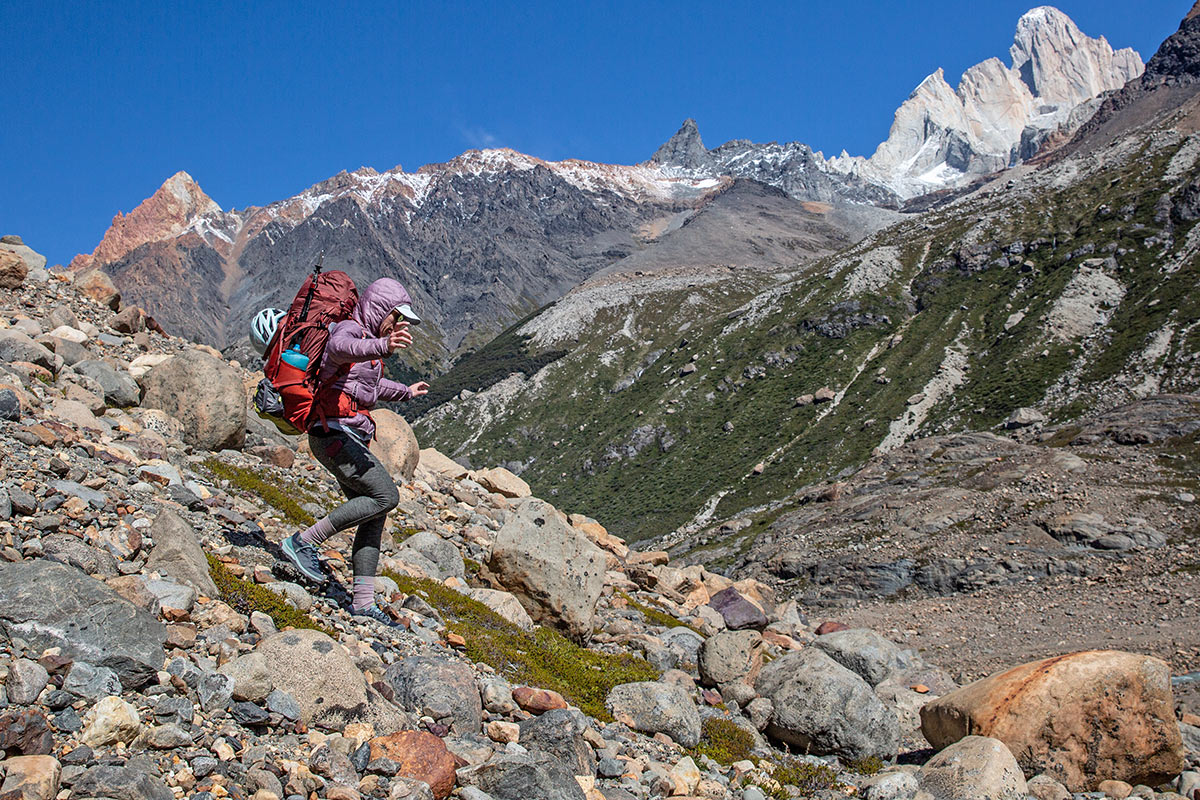
Waterproofing
Most of the hiking shoes here come in both waterproof and non-waterproof versions. The extra protection that comes with a waterproof and breathable membrane inserted into the shoe is a nice security blanket if you plan to hike in the mountains or in shoulder-season conditions, where wet feet can grow cold quickly. In theory, these shoes should keep your feet dry during creek crossings, surprise rainfall, or if you hit snow on an early-season trek. If you go this route, we’ve found Gore-Tex models to work consistently well, and many in-house designs are similarly capable of keeping water out (breathability is a different story), including The North Face’s Futurelight membrane in the Vectiv Fastpack.
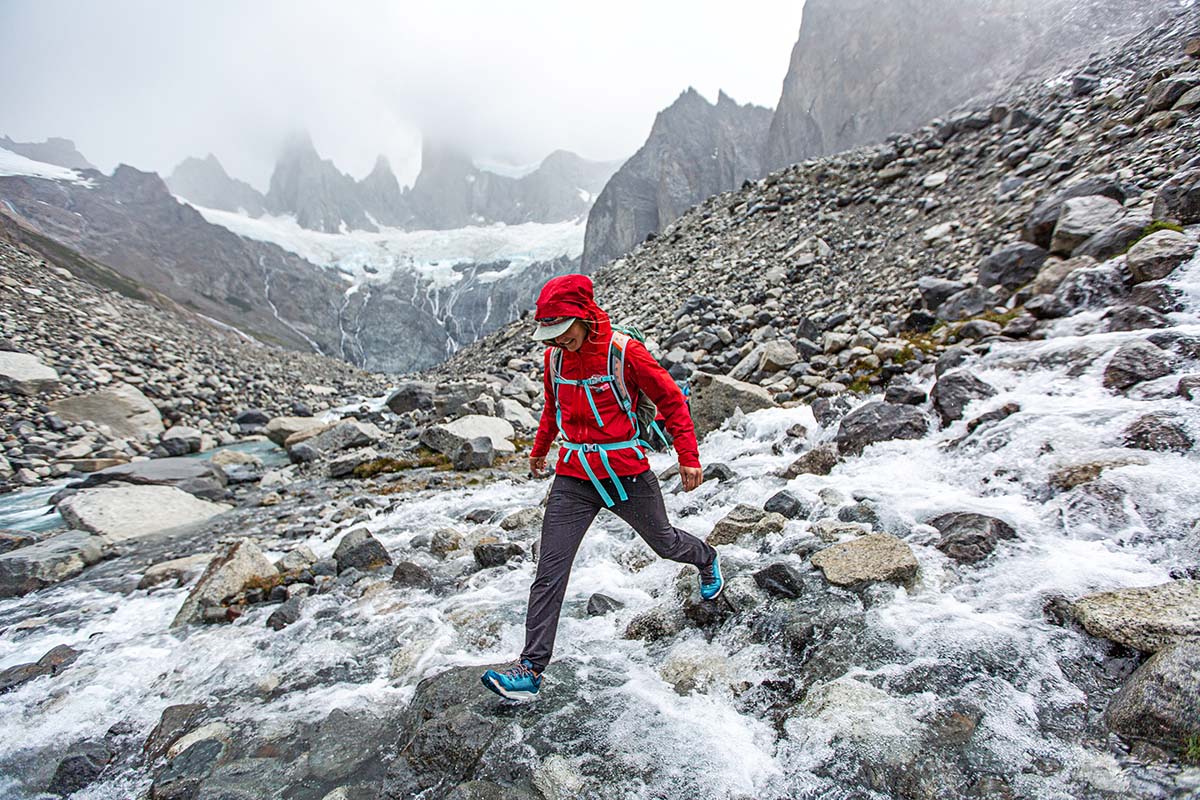
However, there are a number of downsides to going with a waterproof shoe: The extra layer adds weight, impacts breathability fairly significantly (discussed below), and will run you around $20 to $30 more. Further, if you do get water inside your shoe (not a difficult task with a low-top design), it doesn’t drain as well and won’t dry out nearly as quickly as a non-waterproof option. If you tend to get out only in the summer months or live in a hot or dry area, we recommend a non-waterproof shoe in most cases. Another option that we’ve adopted for snowy summer hikes is to pair a non-waterproof shoe with a waterproof sock. This lends a lot of versatility: You get protection when you need it, but your shoe will still dry out quickly after a dousing.
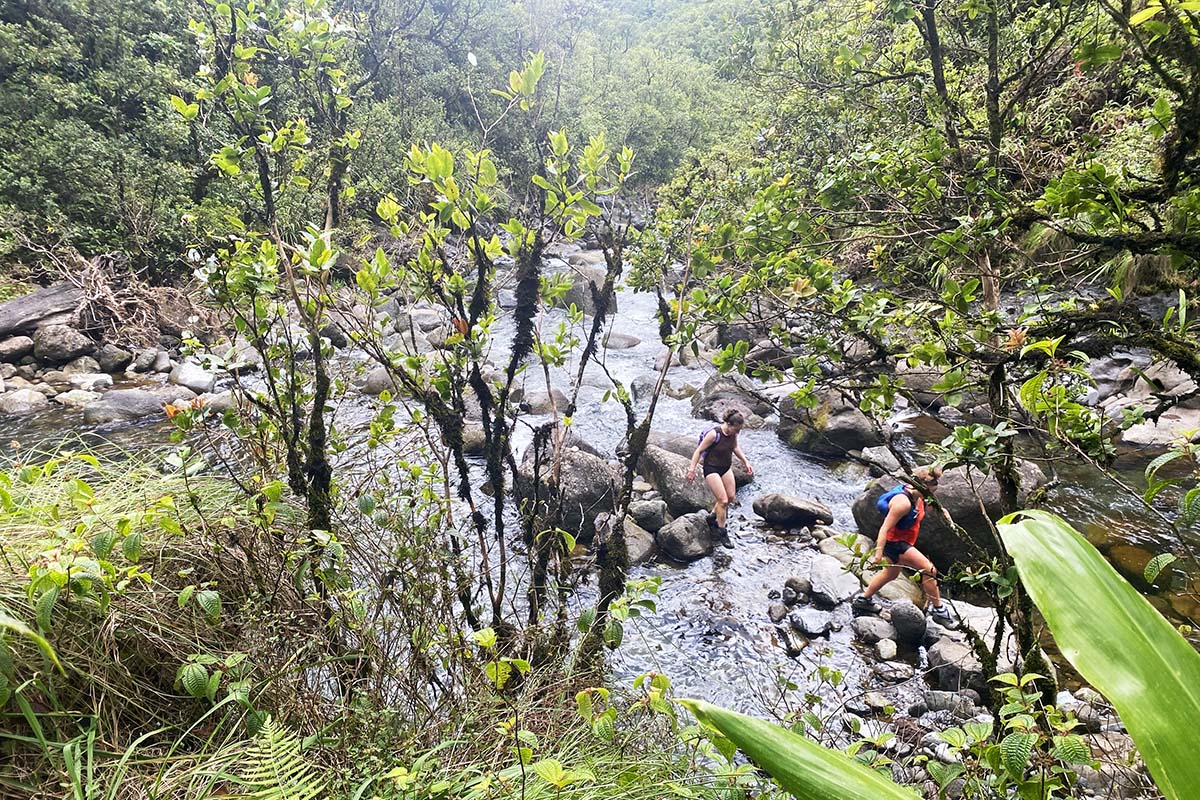
Breathability
The truth about waterproof liners, even expensive Gore-Tex booties, is that they don’t breathe well—just as a waterproof jacket won’t be as breathable as a comparable non-waterproof version. Simply put, waterproof membranes restrict a shoe’s ability to pull moisture away from your sweaty feet as efficiently as a non-waterproof upper. Not all non-waterproof shoes should be treated equally, however. Footwear that features thinner fabrics and a lot of mesh will increase moisture transfer and airflow, which will keep feet less sweaty in hot weather as well as dry out soggy socks far more quickly. On the other hand, full-on leather shoes with built-in waterproofing—the Keen Targhee IV Waterproof comes to mind—will be among the least breathable.
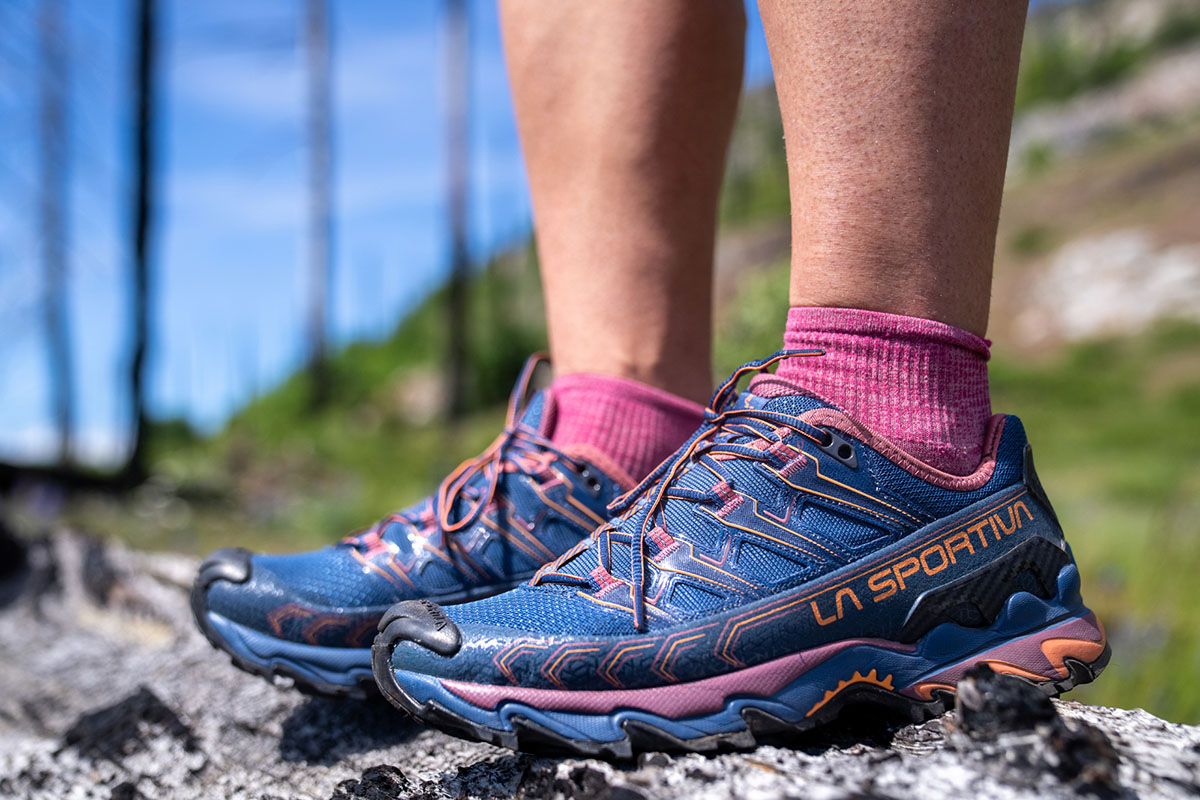
Lacing Systems
Easily overlooked, laces—as well as the lacing system of hooks and eyelets—play an essential role in fit and comfort. If a shoe has a poor lacing system that is prone to loosening, you’ll find yourself having to readjust constantly on the trail. If the system itself doesn’t secure your heel very well, the up and down walking motion will create hot spots and blisters. If the culprit is just the laces themselves, it’s an easy fix: There are a number of quality replacement laces available. But if the system design doesn’t hold your foot very well, we recommend looking elsewhere.

Some models, including the Salomon X Ultra 4 GTX and XA Pro 3D V9 GTX, have a single-pull lacing system. The design is very convenient, and we’ve had no more issues with durability than traditional laces. One thing to keep in mind, however, is that you aren’t able to adjust the tension between eyelets, so the fit will be equally tight across the entire foot. In other words, those with finicky feet that need to fine-tune their laces to be comfortable may be better off avoiding quick-lace designs.
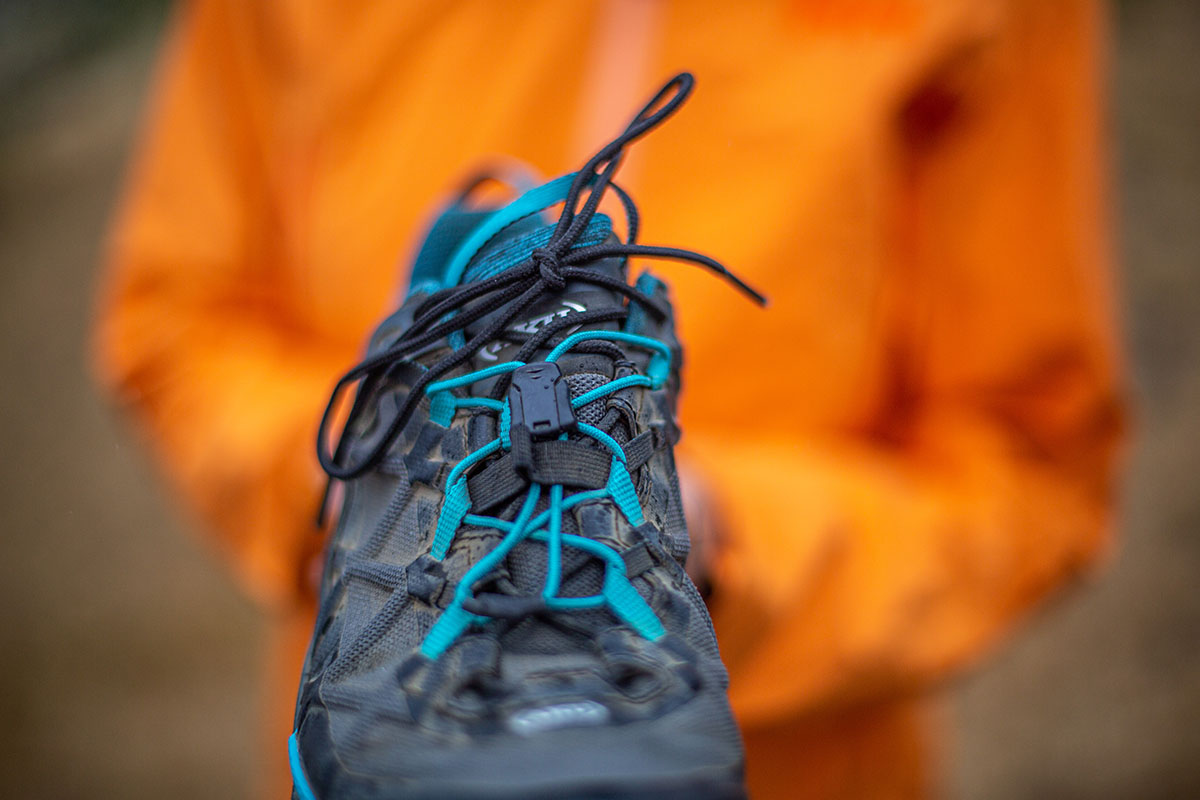
Upper Materials
Hiking shoe upper material is not the most exciting topic, but checking the construction can give helpful insights into the shoe’s performance. The type of material used will correlate directly with a shoe’s longevity, water resistance, and ability to breathe. Most often, hiking shoes are made with a mix of nylon, mesh, and leather to balance cost, weight-savings, and durability. Below, we spell out the pros and cons for the most common materials used for hiking footwear.
Synthetic Nylon and Mesh
Woven synthetic (often nylon) as well as open synthetic mesh panels are commonly used to aid breathability. These materials are not as well known for their durability, but they do a great job cutting weight and are generally easy to break in. Note that synthetic materials don’t conform to your foot over time as well as leather, but in most cases, the overall fit is still comfortable and snug. The majority of our favorite hiking shoes (and almost all modern designs) are made with synthetic materials, which provide a hard-to-beat balance of weight, durability, protection, and breathability.
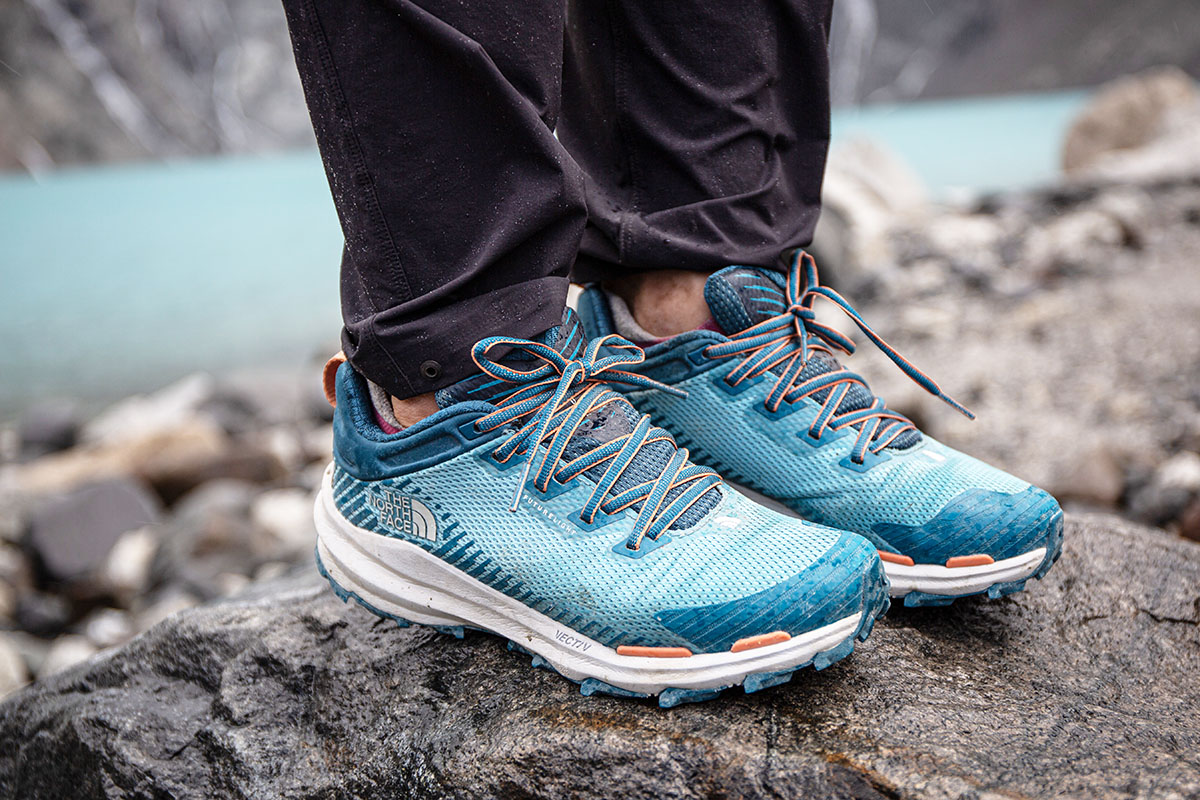
Nubuck Leather
Made of full-grain leather but given a brushed finish that has a suede-like feel, nubuck leather is a common sight on heavier-duty hiking shoes. The softer-touch leather is lighter and more flexible than glossy, full-leather options and more durable than most nylons. It does fall short in breathability, however, and generally weighs more. As a result, it’s common to find a mix of leather and nylon mesh for abrasion resistance and breathability, as seen on the Merrell Moab 3 and Keen Targhee Vent. In the end, if you’re looking to prioritize durability and protection above all else, a leather hiking shoe is a good choice. But in general, these designs are a bit long in the tooth compared to modern synthetic shoes.
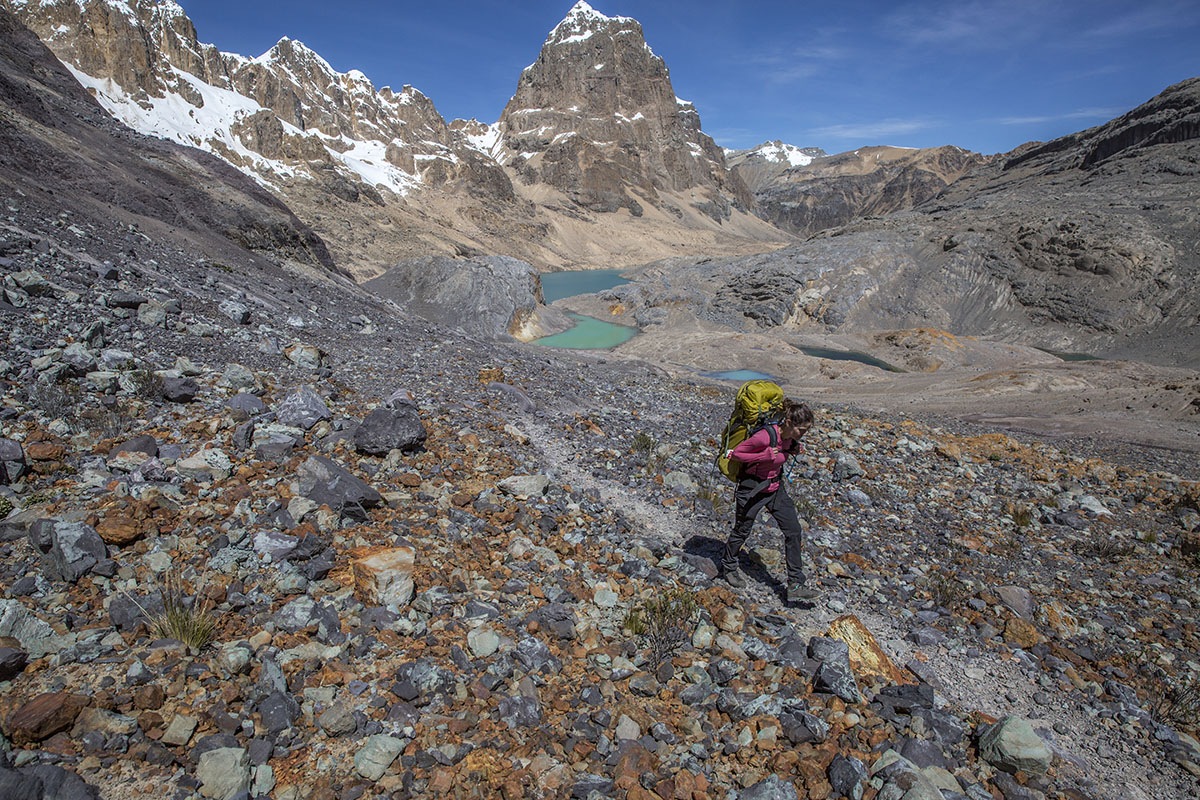
Midsoles: EVA Foam and TPU
The midsole of your hiking shoe functions to cushion your stride, working as a shock absorber from impacts and providing a stable base so your feet don’t have to work so hard on off-camber terrain. Depending on the design, midsoles vary from very thin (minimalist trail runner) to stiff and substantial (burly hiking shoe). Most include EVA, TPU, or a combination of both.
EVA
EVA foam midsoles are a common sight on running and hiking footwear. The cushy, soft material takes some of the sting out of both your heel impact and forefoot spring and is also extremely lightweight. While nearly all shoes on this list use some sort of EVA, designs can vary from super soft to mildly stiff. For logging serious miles on tougher terrain, we prefer a firm and supportive midsole as opposed to too much cushioning. If we’re planning on moving quickly on easy trail, softer cushioning is a better bet and commonly found in trail running designs like the Hoka Speedgoat. However, soft midsoles have a tendency to break down over time, so expect these shoes to pack out more quickly than dedicated hiking shoes.
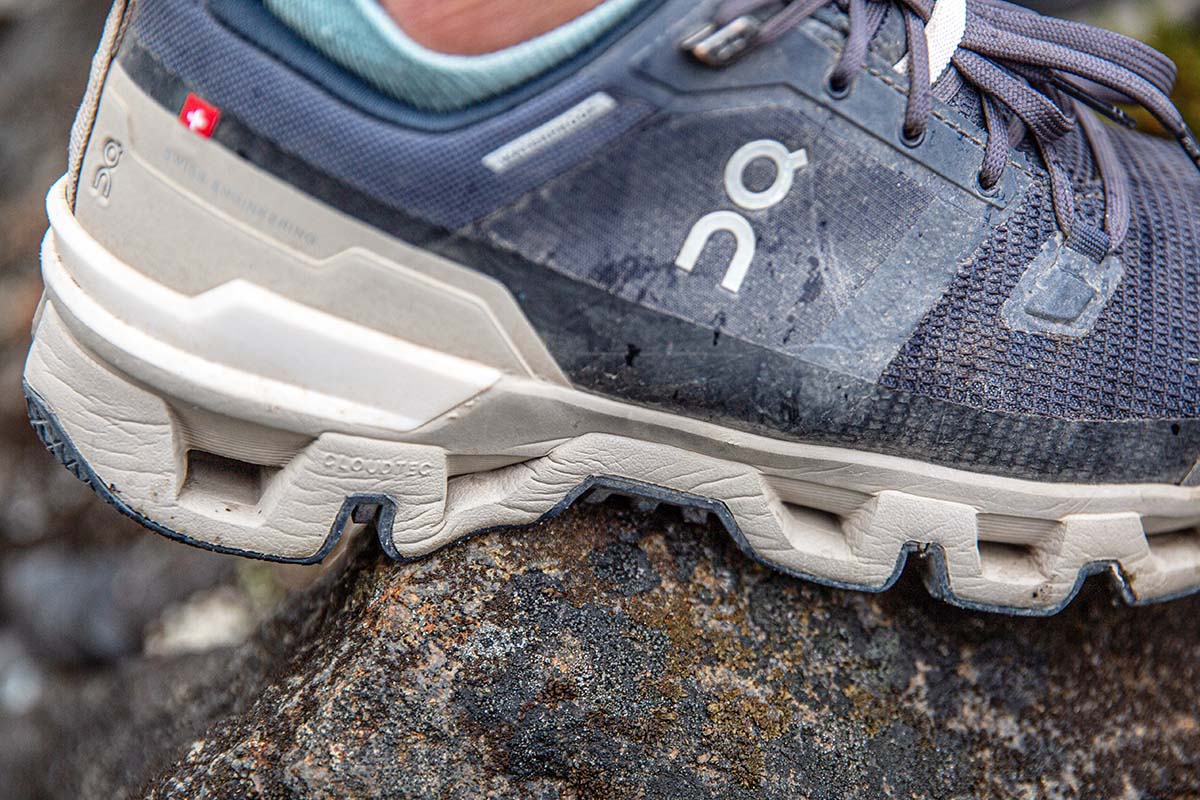
TPU
Thermoplastic polyurethane, shortened (mercifully) to TPU, is a durable plastic commonly found in performance-oriented hiking shoes. Shoes that use TPU underfoot are often less cushy than those with only EVA but will last longer and provide better protection and stability underfoot. In addition, they’ll keep their shape longer and won’t be prone to compressing like EVA. Because both midsole types have valid applications and TPU is more expensive, it’s common for a manufacturer to use a TPU frame or heel for stability and toughness and add in EVA underfoot to increase comfort. Finally, the absence of TPU is a good way to differentiate a trail running shoe from a hiking shoe—most running designs forgo this plastic in order to stay flexible and cushioned, but the trade-off is less stability and isolation from rough terrain.
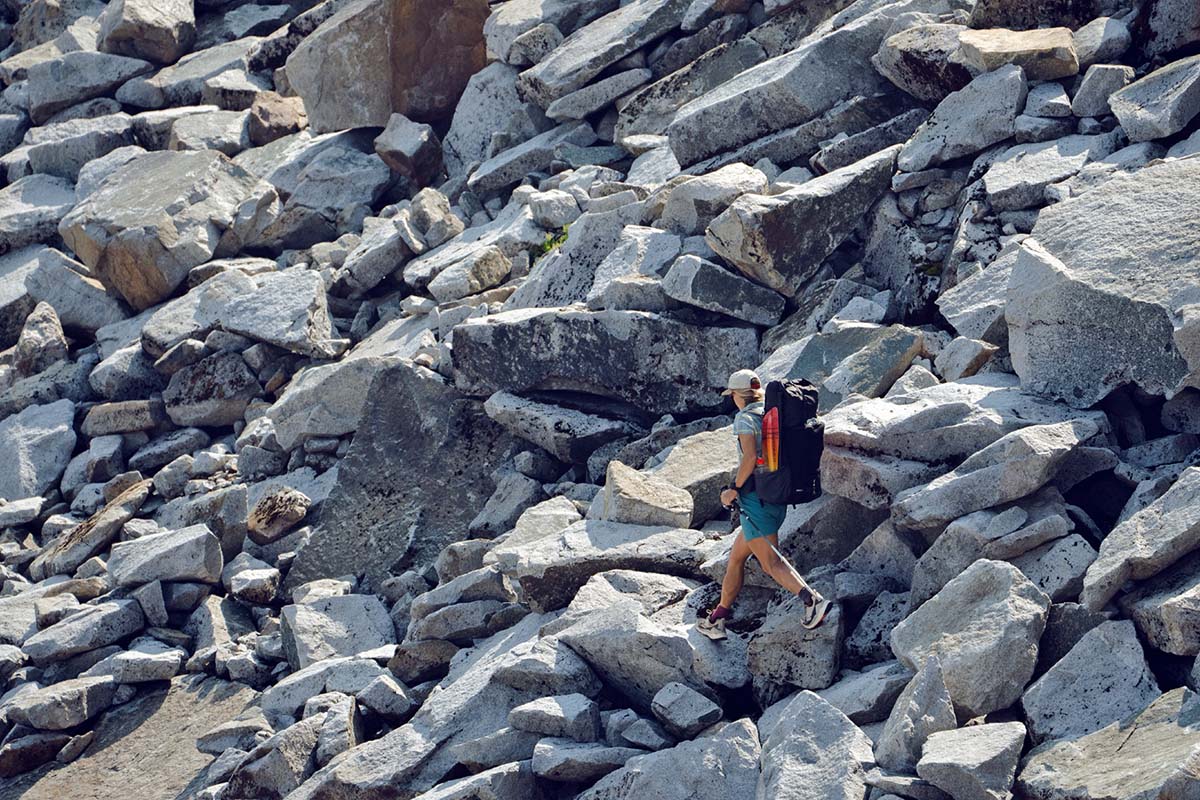
Outsoles and Traction
One of the hallmarks of a hiking shoe is good traction on a variety of terrain. In a way that more casual footwear can never match, hiking and trail running footwear are leaps and bounds better when the going gets rocky, slippery, and steep. Vibram is the gold standard when it comes to outsole rubber, but not all Vibram compounds should be treated equally: The rubber manufacturer tailors their blends and designs for the specific footwear and brand. Some shoes have much larger and sharper lugs underfoot for serious grip in mud, while others prioritize sticky rubber for scrambling over rocks.
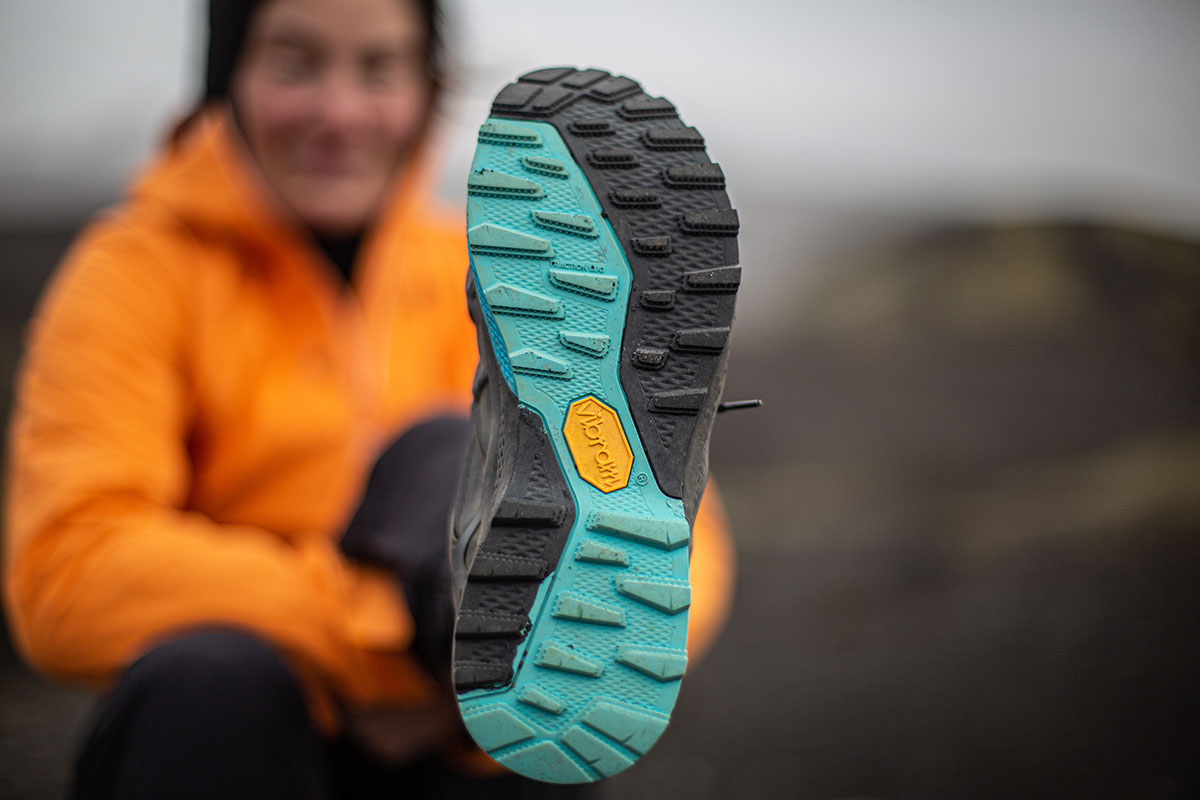
Salomon is one brand that doesn’t outsource their traction needs. Instead, they use their in-house Contagrip for all of their hiking and trail running models. We’ve found the level of quality and performance is on par with Vibram’s offerings, from anything from their fast-and-light X Ultra 4 hiking shoes to the burly Quest 4 backpacking boots. Like Vibram, Contagrip compounds can vary between shoes and there are a number of different compounds, including Contagrip MA, MD, and TA.
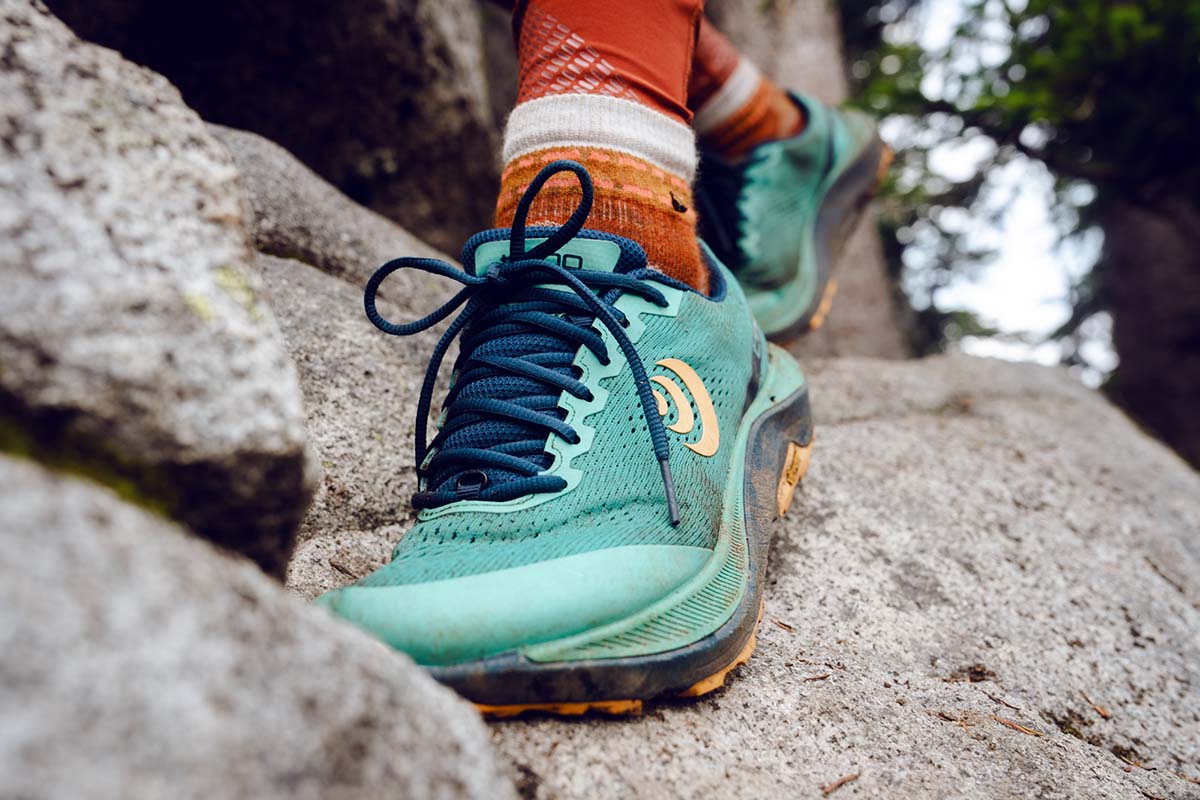
Toe Protection
Hiking trails, even well-maintained ones, are full of rocks, roots, and other potential hazards, so we almost always recommend a hiking shoe with some type of toe cap. Lacking any protection on the front of your shoes can lead to a trip-ruining impact when you inevitably look up from the trail to enjoy the scenery. Hiking shoes typically have a full rubber toe cap, but trail runners sometimes have a trimmed-down version or none at all—one of the compromises in opting for a minimalist shoe. Approach shoes like the La Sportiva TX4 Evo, on the other hand, have exceptional protection with a standard wraparound rubber rand and stiff midsole and outsole.
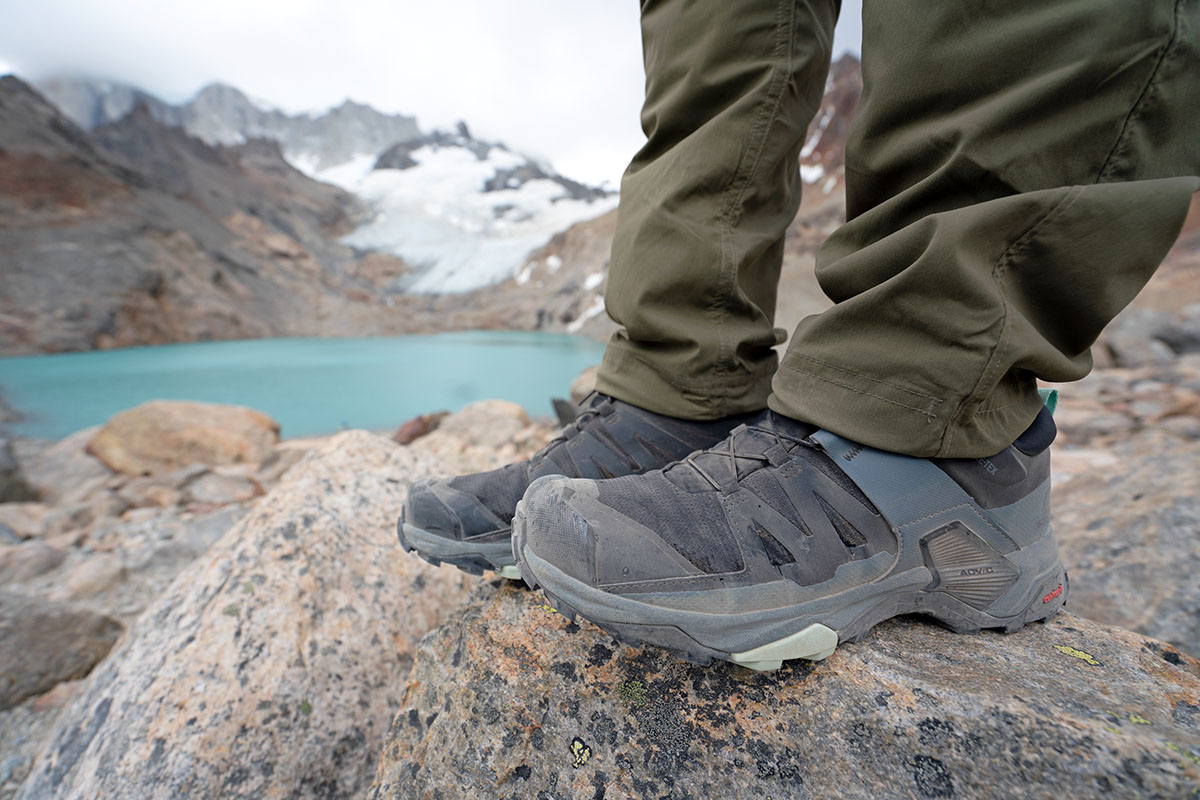
Insoles
Just like with running shoes, the stock insoles that come with nearly every hiking shoe are generally fairly cheap. For some, this might not make a difference, but for others, it’s what separates comfort from misery. Thankfully, removing your insoles is super easy, and replacing them with an aftermarket model that’s specific to your foot size and shape can remedy most shoe maladies. New insoles can provide more or less volume to fill out the shoe, improve the fit under the arch, and increase or decrease the cushion and impact absorption. We recommend checking out Superfeet insoles for their wide selection of options and trusted reputation in daily shoes, ski boots, and hiking footwear.
Sustainability
In 2024, one of the main ways that brands are innovating is with sustainable design practices that seek to mitigate our impact on the planet. When it comes to footwear, manufacturers are turning to recycled and recyclable materials for everything from laces and lining to foam midsoles and rubber outsoles. Another way to shop sustainability is to keep durability in mind—if it fits your hiking style, a shoe with a more hardwearing upper and sole might last you twice as long as a trail runner, which cuts your consumption in half. Or, opt for shoes that are designed to be resoled, such as the La Sportiva TX4 Evo. It’s also worth noting services like Danner’s Recrafting, which is committed to rebuilding and resoling footwear to keep it on the trail and out of the landfill. And when the time does come to retire your beloved hiking shoes, consider recycling them via programs like Ridwell or Terracycle.
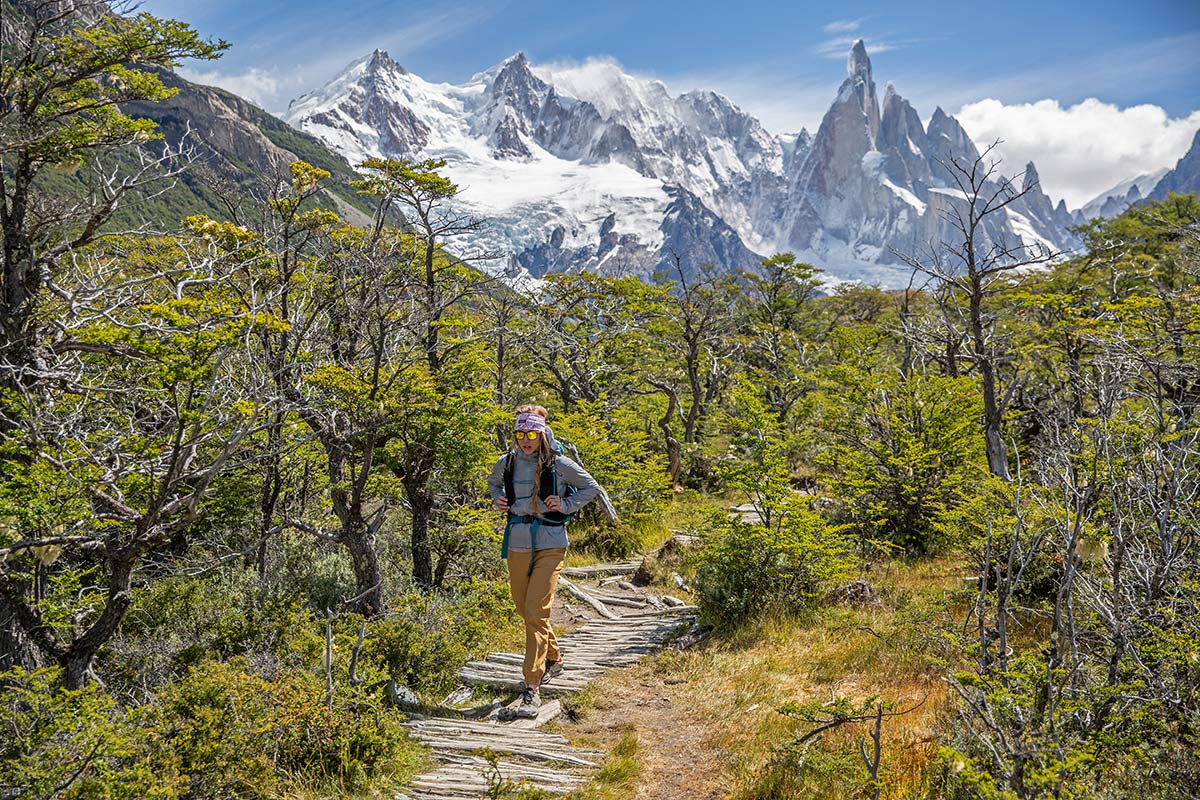
Hiking Shoes vs. Hiking Boots
One of the biggest trends we see across the board in the outdoor space is the move towards lighter-weight gear. This is exemplified in the world of hiking footwear, where, in just a couple short decades, we’ve gone from 4-pound leather boots being standard issue to the majority of hikers now wearing lightweight hiking shoes or trail runners. However, hiking boots still have their place, particularly for rugged terrain and schlepping a heavy multi-day load. We also specifically recommend a mid-height shoe for those needing extra protection around their ankles.
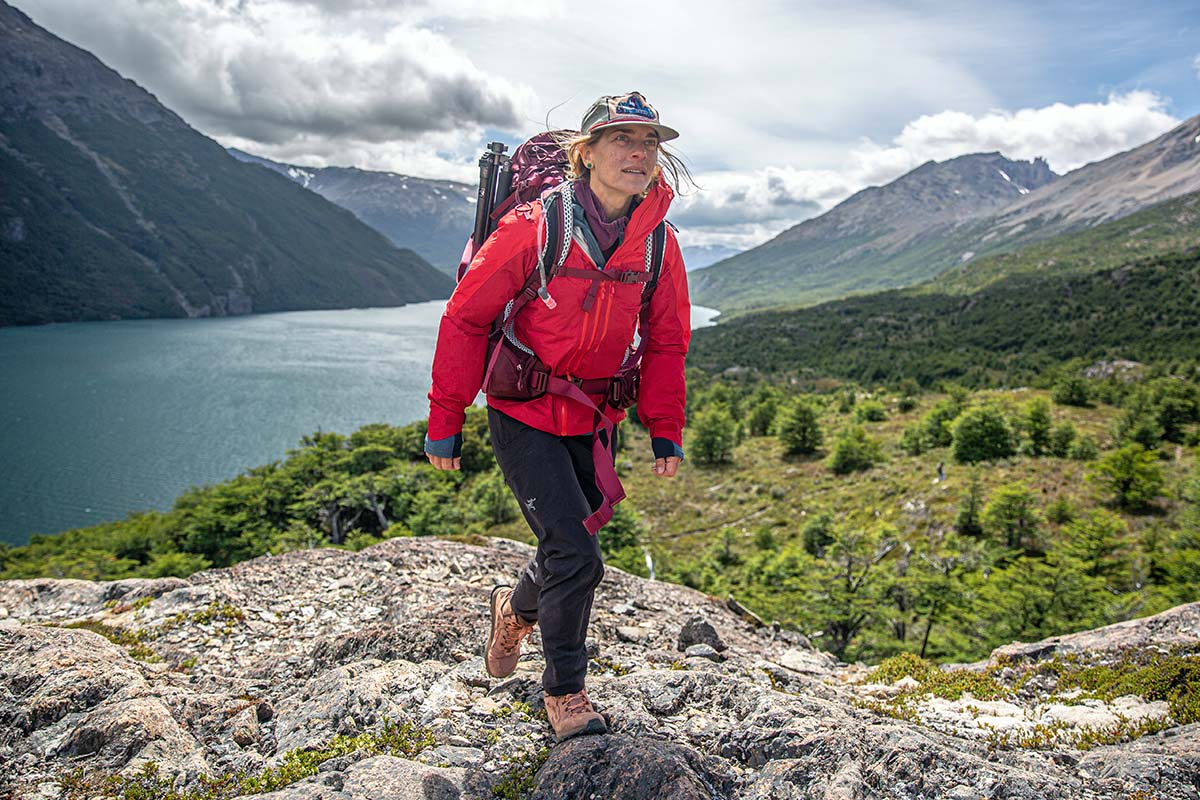
The biggest point of differentiation between hiking shoes and boots is height: Shoes have a low-top fit, while boots generally sit above the ankle. Given their increased coverage, boots are able to offer a more secure fit, better stability, and more protection overall. Similar to hiking shoes, most modern hiking boots are built with lightweight materials and nicely balance agility and performance (even the Altra Lone Peak trail runner comes in the mid-height Hiker 2 and All-Wthr Mid 2). That said, for anything but the most rugged of trails or the heaviest loads, we usually find ourselves reaching for a hiking shoe. You’ll have to decide for yourself, but both are viable options for day hiking, backpacking, and non-alpine peak bagging. For our breakdown of the top models on the market—including everything from mid-height trail running shoes to traditional leather designs—see our article on the best women’s hiking boots.


